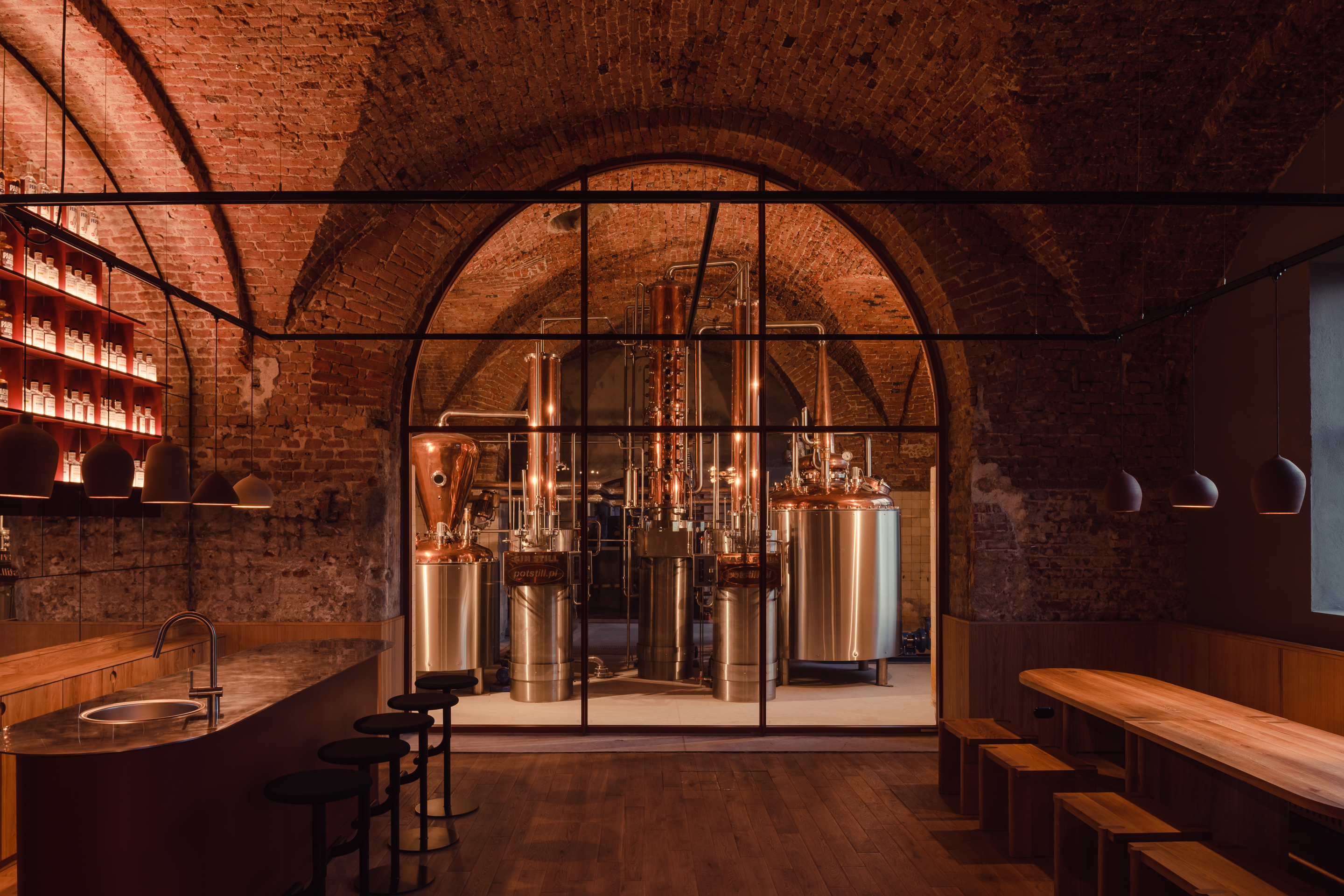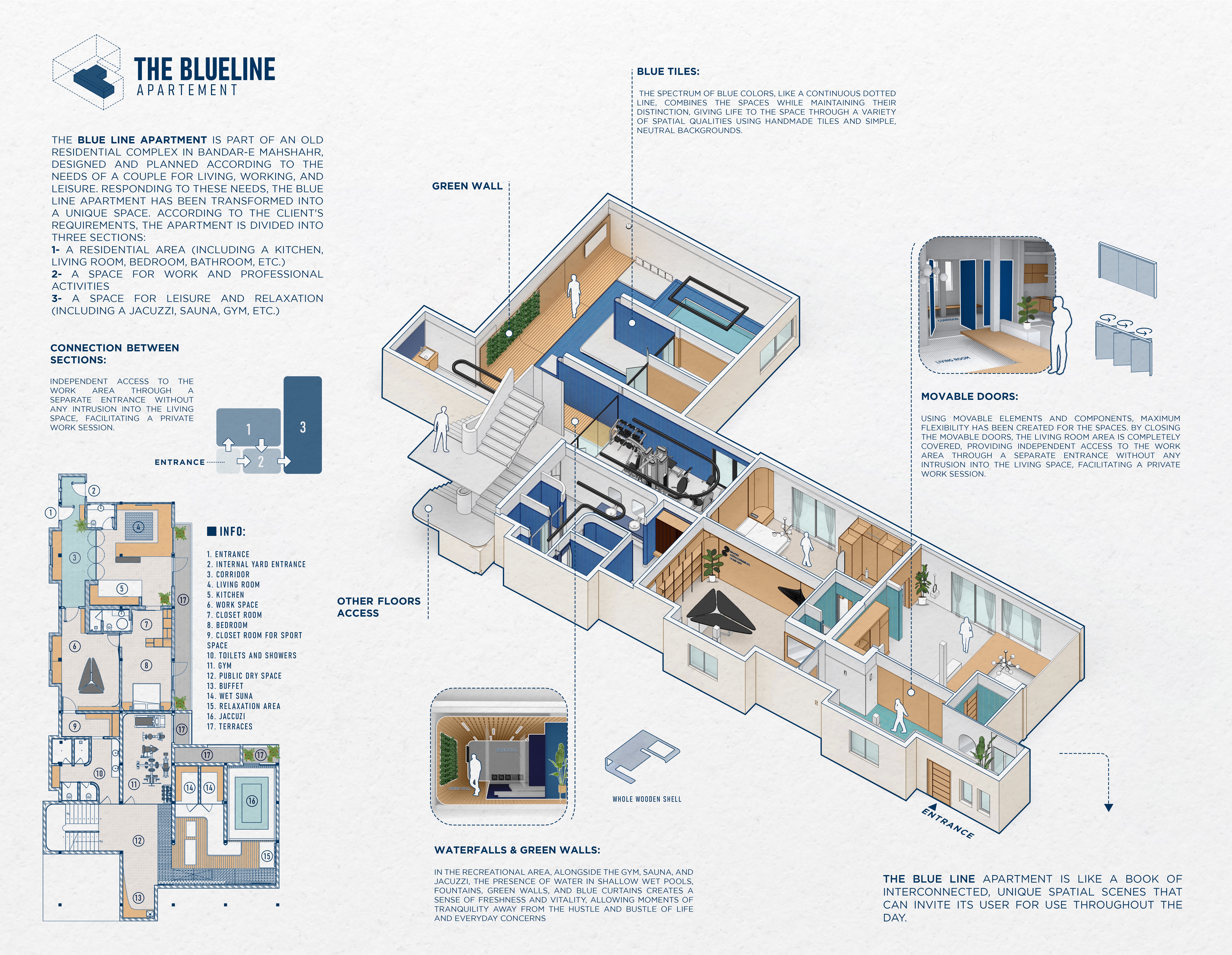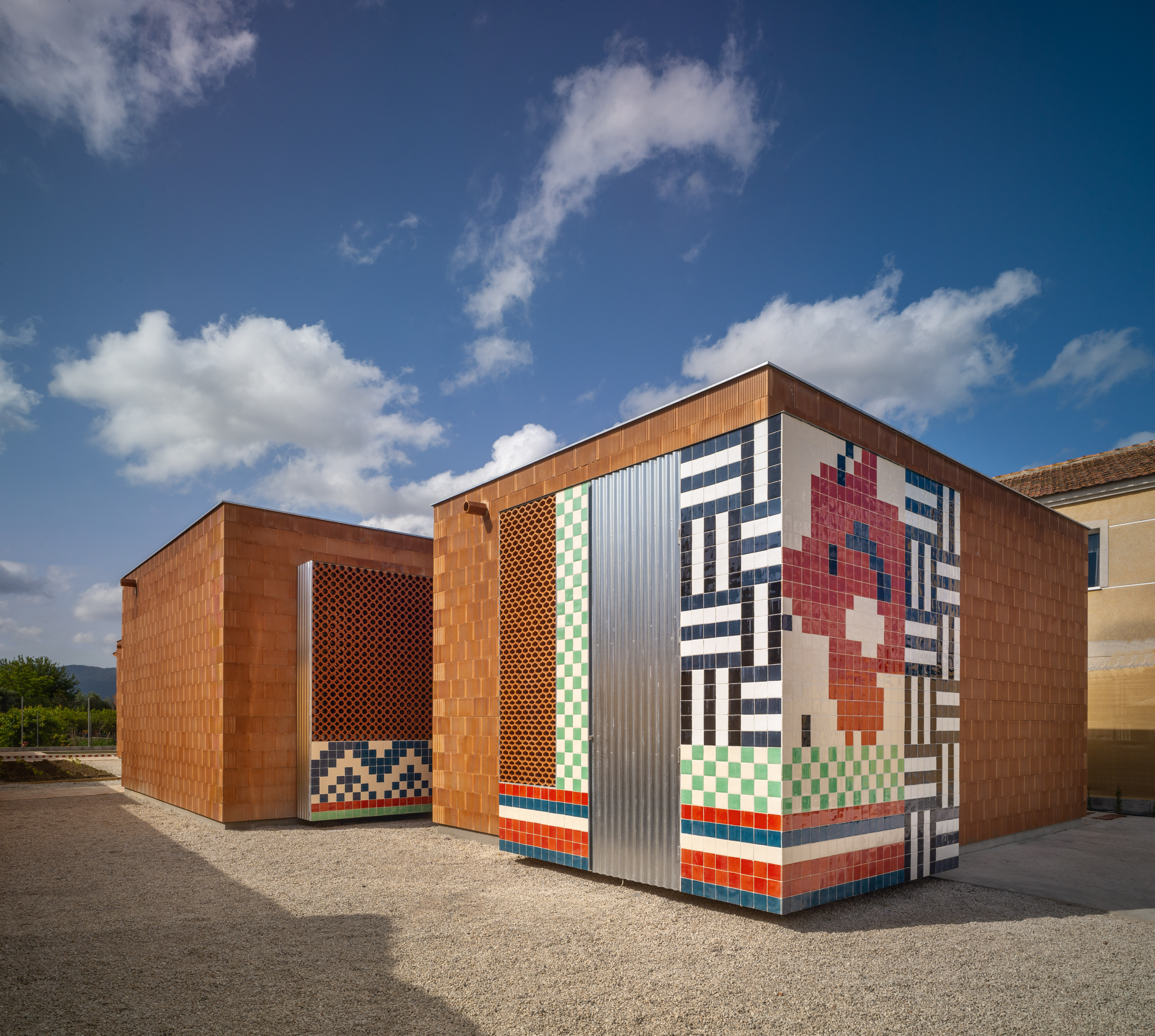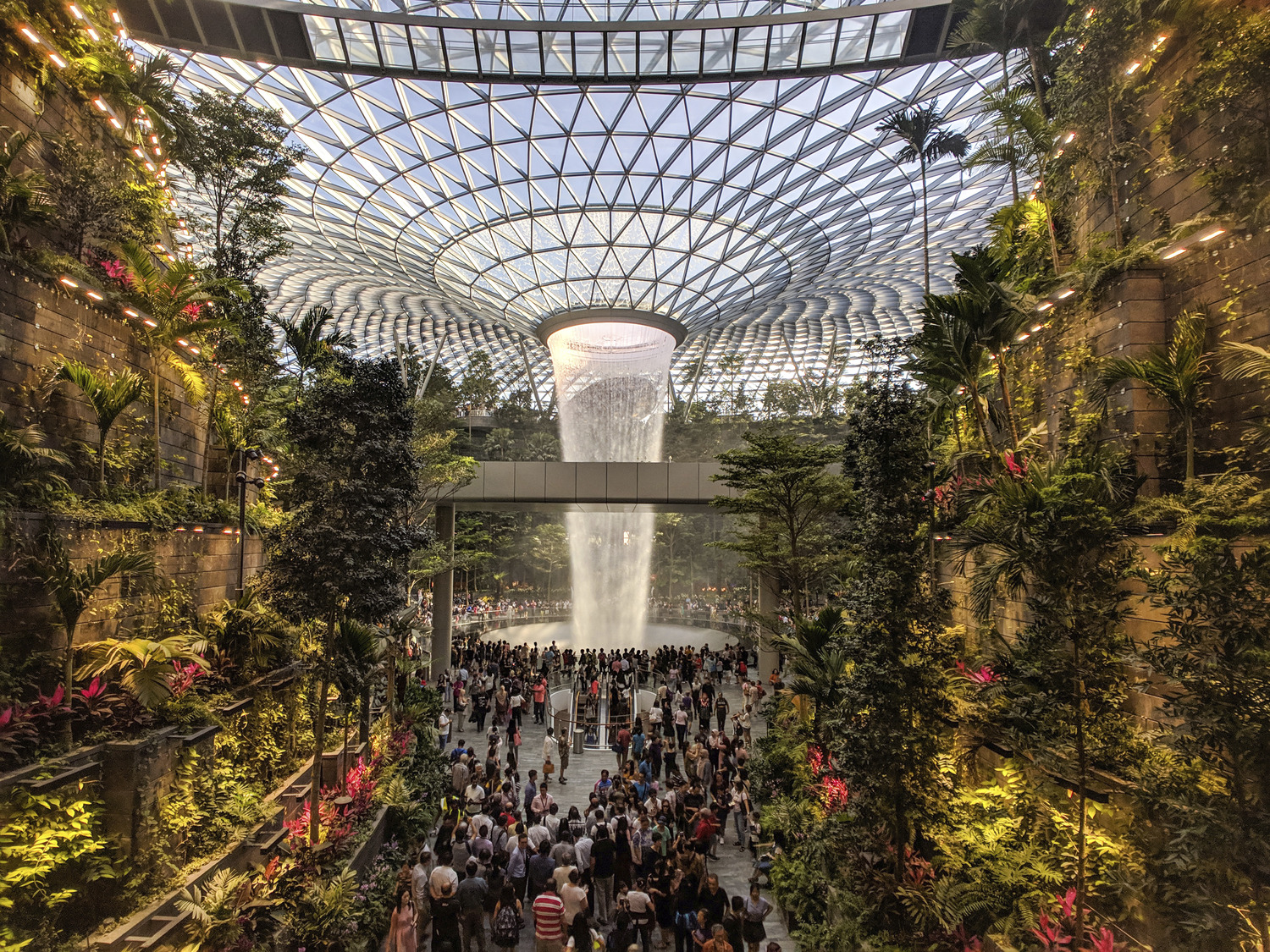30 Best Architecture and Design Firms in Iran
These annual rankings were last updated on August 22nd, 2024. Want to see your firm on next year’s list? Continue reading for more on how you can improve your studio’s ranking.
Iran is the second largest country in the Middle East. It is vastly characterized by its diverse cultural heritage and history and distinct landscape topology. After becoming an independent country in 1979, Iranian architects had to find ways to preserve this vivid historical fabric while also satisfying society’s growing needs. The country also holds a strategic geographical position and valuable natural resources, which, unfortunately, has led to many geopolitical and economic challenges. In this context, architecture played a definitive role, especially under the umbrella of cultural and environmental sustainability.
Responding to the vastly changing urban and natural landscapes as well as the water scarcity and desertification, Iranian architects have prioritized topographically as well as socially impactful architectural designs that aid local communities. Currently, their designs are a blend of tradition and modernity that has introduced a new, contemporary layer to Iranian architecture, while operating at the highest levels of sustainable design.
With so many architecture firms to choose from, it’s challenging for clients to identify the industry leaders that will be an ideal fit for their project needs. Fortunately, Architizer is able to provide guidance on the top design firms in Iran based on more than a decade of data and industry knowledge.
How are these architecture firms ranked?
The following ranking has been created according to key statistics that demonstrate each firm’s level of architectural excellence. The following metrics have been accumulated to establish each architecture firm’s ranking, in order of priority:
- The number of A+Awards won (2013 to 2024)
- The number of A+Awards finalists (2013 to 2024)
- The number of projects selected as “Project of the Day” (2009 to 2024)
- The number of projects selected as “Featured Project” (2009 to 2024)
- The number of projects uploaded to Architizer (2009 to 2024)
Each of these metrics is explained in more detail at the foot of this article. This ranking list will be updated annually, taking into account new achievements of Iran architecture firms throughout the year.
Without further ado, here are the 30 best architecture firms in Iran:
30. ArmaniArchitects

© ArmaniArchitects
?rmani ?rchitects is an innovative multidisciplinary collaborative practice founded by Amir Armani Asl and Kiana Ghader that focuses on architecture, interior design, landscape design, custom fabrication, parametric design and design objects.
Some of ArmaniArchitects’s most prominent projects include:
- INFILOOLION Pavilion, Tehran Province, Iran
- Sandy Darak Pavilion, Chabahar, Iran
- London Energy Pavilion 2016, London, United Kingdom
- Iceland Thermal Springs Guest House/ Vogafjós Green Heritage, Iceland
- China Wine Cultural Center, China
The following statistics helped ArmaniArchitects achieve 30th place in the 30 Best Architecture Firms in Iran:
| Featured Projects | 2 |
| Total Projects | 5 |
29. Boozhgan Architectural Studio

© Boozhgan Architectural Studio
Boozhgan Architectural Studio was established in 2007 and is based in Tehran. Their work revolves around residential architecture.
Some of Boozhgan Architectural Studio’s most prominent projects include:
- Asef Office Building, Tehran, Iran
- Haiat- e – Elahie Residential Building, Tehran, Iran
- Renovation Of a House, Zanj?n, Iran
- NEGAH OFFICE BUILDING, Tehr?n, Iran
- Baranoosh Residential Building , Tehr?n, Iran
The following statistics helped Boozhgan Architectural Studio achieve 29th place in the 30 Best Architecture Firms in Iran:
| Featured Projects | 2 |
| Total Projects | 11 |
28. FEASTUDIO

© FEASTUDIO
The office of “Fundamental Architectural Experience” [FEASTUDIO] was founded by Arash Nasiri and Ensieh Khamse in 2006. The office has tried so far to achieve a consistent, coherent language in their work based on their progressive experiences and the relations between the ideas and the work, a distinctive language by which to avoid architectural production being merely in the line of exigency and to push boundaries in order to let creativity and active, multilateral strategies in.
Some of FEASTUDIO’s most prominent projects include:
- The noor e mobin primary school, Iran
- Noor-e-Mobin Sports Hall, Semnan, Iran
The following statistics helped FEASTUDIO achieve 28th place in the 30 Best Architecture Firms in Iran:
| A+Awards Finalist | 1 |
| Featured Projects | 2 |
| Total Projects | 2 |
27. Cedrus Studio

© Cedrus Studio
Cedrus is a Tehran-based, research-driven design and construction studio founded by Mohammad Mehdi Saeedi in 2017. The studio supported by a passionate team of skilled architects, landscape architects and interior designers. The studio’s projects range from single-family villas to residential, commercial and mixed-use large-scale complexes.
Some of Cedrus Studio’s most prominent projects include:
- Peyvand Residential Building, Tehran, Iran
- Cedrus Residential Building, Tehran, Iran
- Villa 174, Babolsar, Iran
- Elite Cafe, Tehran, Iran
- Shariat Villa, Karaj, Iran
The following statistics helped Cedrus Studio achieve 27th place in the 30 Best Architecture Firms in Iran:
| A+Awards Finalist | 1 |
| Featured Projects | 2 |
| Total Projects | 14 |
26. KOUROSH RAFIEY Architectural Design Studio(KRDS)

© KOUROSH RAFIEY Architectural Design Studio(KRDS)
Kourosh Rafiey Architectural Design Studio is a full architectural and engineering services firm practicing on the study to producing work of lasting value. Kourosh Rafiey founded KRDS in 2006 motivated to design quality. Before that he was design director of Asar Consultant Engineers’ Co. since 1997 and practice as an independent designer. He had many works constructed & currently under construction; some of which have received national and international recognition. Examples of his works are published either online or in international magazines such as AD. The scope of work concerns the adjustment of all stages of design and technical expertise to oversee construction.
Some of KOUROSH RAFIEY Architectural Design Studio(KRDS)’s most prominent projects include:
- Sohanak Swimming Pool, Tehran, Iran
- Vault on vault, Royan, Iran
- The National Pantheon of Kazakhstan, Astana, Kazakhstan
The following statistics helped KOUROSH RAFIEY Architectural Design Studio(KRDS) achieve 26th place in the 30 Best Architecture Firms in Iran:
| A+Awards Winner | 1 |
| Featured Projects | 2 |
| Total Projects | 3 |
25. TDC office

© TDC office
Sara Kalantary and Reza Sayadian are practicing architects who founded TDC Office in 2002. What differentiates them is the answers they give to the world around them, and a humble view, yet critical is easily traced in their works. Such view can be observed in numerous projects where unique solutions are rendered compared to typical methods of design and construction.
Respect for human being and habitat, and a constant search for finding appropriate ideas, are based on the fact that creating a world full of unique recommendations can alter people’s deduction towards possible phenomena.
For them, architecture is a dynamic phenomenon. They look at it as part of the city so that it can create memories. Dynamic presence of human in the city and home, as well as the flow of life in them are the most invaluable part of creating a space which insinuate that architecture is the way to embrace the world.
Sarah and Reza’s works, with their unique approach and ideas, have managed to win several international as well as national awards. Students as well as university professors have also taken notice of their work, both inside and outside the country. Such occurrences have resulted in their works being published in many authentic books and magazines all around the world.
Some of TDC office’s most prominent projects include:
- Saba Apartment, Tehran, Iran
- Plus Machine, Tehran, Iran
The following statistics helped TDC office achieve 25th place in the 30 Best Architecture Firms in Iran:
| A+Awards Winner | 1 |
| Featured Projects | 2 |
| Total Projects | 2 |
24. ReNa Design

© Reza Najafian
Founded in 2012, ReNa Design is a young architectural group active in design, architecture and research. The office is primarily concerned with issues of functionality and context. This approach is easily seen through the firm’s projects, ranging in different categories and types. ReNa Design pays a great amount of attention and care to materials and construction technology which are in turn applied to completely innovative and non-conventional conditions. Since its inception, ReNa Design has won many national awards and competitions in fields of architecture, design and interior design.
Some of ReNa Design’s most prominent projects include:
- Afsharian’s House, Kermanshah, Iran
- Zafar Dental Office, Tehran, Iran
- Diyar Media Studio, Tehran, Iran
The following statistics helped ReNa Design achieve 24th place in the 30 Best Architecture Firms in Iran:
| A+Awards Winner | 1 |
| Featured Projects | 3 |
| Total Projects | 3 |
23. Arsh4d Studio

© Arsh4d Studio
Arsh4d Studio has been founded by Alireza Sherafati & Pantea Eslami in 2012 to provide full range of architectural services to both the public and private sectors. Alireza Sherafati & Pantea Eslami were previously the founding partner of the ARSH DESIGN STUDIO. In the work of Arsh4d, environmentally conscious design has become an integral consideration in the formulation of architectural ideas and in the spatial experience embodied in each completed project.
Some of Arsh4d Studio’s most prominent projects include:
- Stacked Garden Villas, Namakabrud, Iran
- Candy Shop, Tehran, Iran
- Villa Residential, Tehran, Iran
- UP VILLA, Abali, Iran
- ARG Shopping Mall, Tehran, Iran
The following statistics helped Arsh4d Studio achieve 23rd place in the 30 Best Architecture Firms in Iran:
| A+Awards Winner | 1 |
| A+Awards Finalist | 1 |
| Featured Projects | 1 |
| Total Projects | 5 |
22. ayeneh office

© ayeneh office
Architects of the Ayeneh Office believe that architecture like a mirror should reflect the context or the surrounding environment in the general sense. Context in this regard refers to the setting that a project begins to happen. Architecture welcomes the good way of living in a place and accepts its goodness. In other words, architecture, in one sense, acts as mirror to reflect the life of its context, and broadly speaking, it even reflects many features of the context (such as technology, crafting skills, economics, politics, crafting duration, and culture). The approach and design method in the Ayeneh office is to delve into the heart of both the subject and the place in order to reflect or increase their desirability. We try to excavate the project subject – which is the life that is going to flow in it –as well as its location to find the initial concepts shaping the design, and then epitomize it in our architecture.
Some of ayeneh office’s most prominent projects include:
- House of Niches, Najafabad, Iran
- Andarzgoo Residential Building, Tehran, Iran
- Bahar House, Najafabad, Iran
The following statistics helped ayeneh office achieve 22nd place in the 30 Best Architecture Firms in Iran:
| Featured Projects | 3 |
| Total Projects | 3 |
21. Alidoost & Partners

© Alidoost & Partners
Founded and directed by Shahab Alidoost and Sona Eftekharazam, Alidoost and Partners is a multidisciplinary office that focuses on architecture and design, from large scale planning to furniture. Rich with multiple expertises, our office is fuelled by talented designers and experienced architects that jointly develop projects from early sketches to on-site supervision. All of which, regardless of scale, outlines an approach that is affirmatively social in its outcome, enthusiastic in its ambition and professional in its process. At the core of our architecture is the ability to take a fresh look at design issues through experienced eyes. Our approach aims at turning intense research and analysis of practical and theoretical matters into the driving forces of design. By continuously developing rigorous methods of analysis and execution, Alidoost & Partners is able to combine innovative thinking and efficient production.
We work with corporate, government and private clients in numerous countries to realize major civic, hotel, residential, office, commercial and educational developments. We carefully limit the commissions we take on to help ensure a high degree of professional attention and overall project quality. Alidoost &Partners envisions itself as a proactive partner for its client, rather than a consultant. The office has a wide portfolio of international work and the attitude of involving external consultants to improve the design intelligence of a given project team. The use of complementing teams ensures that a project will never suffer from being neither too conventional nor too naive.
Some of Alidoost & Partners’s most prominent projects include:
- GOLIRAN Flower Shop, Rasht, Iran
- 3×2, Tehran, Iran
- MIKA-911, Tehran, Iran
- “NILOOFAR” Residential Building, Tehran, Iran
- Facade Renovation of ALVAND Office Building, Tehran, Iran
The following statistics helped Alidoost & Partners achieve 21st place in the 30 Best Architecture Firms in Iran:
| Featured Projects | 3 |
| Total Projects | 12 |
20. HABIBEH MADJDABADI Architecture Studio

© HABIBEH MADJDABADI Architecture Studio
HABIBEH MADJDABADI, born in 1977, is an Iranian architect, author, designer, and speaker. In 2002 she graduated by a Master’s degree in architecture from Azad University of Tehran and started her professional career in 2003 by establishing her design studio in Tehran right after winning first prize in the design competition of restoring a historical building (belonging to Zand dynasty) in Iran. Since then she has received several awards and recognitions, among which are: shortlisted for Aga Khan Award 2016 and Tamayouz Women in Architecture and Construction Award 2019, winner of Chicago Award 2014, Worldwide Brick Award 2014, and MEMAR Award 2014.
Some of HABIBEH MADJDABADI Architecture Studio’s most prominent projects include:
- Genetic Mutation II (Villa CHAR BAGH ), Karaj, Iran
- VALIASR Square, Tehran Province, Iran
- Mahtabi House, Golpayegan, Iran
- 40 Knots House, Tehran, Iran
- Mellat Bank Pilot Façade, Tehran, Iran
The following statistics helped HABIBEH MADJDABADI Architecture Studio achieve 20th place in the 30 Best Architecture Firms in Iran:
| Featured Projects | 3 |
| Total Projects | 13 |
19. BRACKET DESIGN STUDIO

© BRACKET DESIGN STUDIO
Bracket Design Studio is a full-service design firm founded in 2006 by Shervin Hosseini. We offer services in urban design, interior space planning, furniture design and architecture from micro to macro scale. Our highly collaborative staff comes from wide-ranging theoretical and practical backgrounds, including designing, scripting, planning and construction of public and private projects. Offering innovative insights, materials and technology into our projects, we strongly consider the available possibilities of the site and the needs of clients in order to find the best solutions by constantly revising and redefining the projects. Each project, for us, entails its own singular approach which is essentially developed out of experience and intuition.
Some of BRACKET DESIGN STUDIO’s most prominent projects include:
- Baghjanat , Isfahan, Iran
- Vila 131, Isfahan, Iran
- House No.47 , Isfahan, Iran
- Vienna Liquid Garden, Vienna, Austria
- Adl Complex , Tehran, Iran
The following statistics helped BRACKET DESIGN STUDIO achieve 19th place in the 30 Best Architecture Firms in Iran:
| Featured Projects | 3 |
| Total Projects | 47 |
18. KanLan [Kamran Heirati, Tallan Khosravizadeh]
![© KanLan [Kamran Heirati, Tallan Khosravizadeh]](https://architizer-prod.imgix.net/media/mediadata/uploads/1634974310356Villa_Darya-Kenar_-_Exterior_Render_001.jpg?fit=max&w=1680&%23038;q=60&%23038;auto=format&%23038;auto=compress&%23038;cs=strip)
© KanLan [Kamran Heirati, Tallan Khosravizadeh]
Kamran Heirati Architects was established to enhance the architecture and human experience by incorporating Iran’s authentic culture into its designs and respond to today’s community challenges. Established in 2001, this office has produced award-winning architectural and interior design projects across Iran and other countries.
Some of KanLan [Kamran Heirati, Tallan Khosravizadeh]’s most prominent projects include:
- Villa Shali-Kar, Mazandaran Province, Iran
- Villa-Safadasht, Malard Road, Karaj, Iran
- Villa Hayat-Khaneh, Mazandaran Province, Iran
- Villa Daryakenar, Mazandaran Province, Iran
| A+Awards Finalist | ”1″ |
| Featured Projects | ”3″ |
| Total Projects | ”4″ |
17. BonnArq Architects

© BonnArq Architects
Behzad Atabaki has founded “Behzad Atabaki Studio” in 1999 and also co-founded “BonnArq Architects” in 2014 which both are recognized for their works in art, architecture, urban design, and landscape architecture. Winning the first prize in the competition, together with Parshia Qaregozloo, he has been the co-curator of the Iran Pavilion at Venice Architecture Biennale 2016. In 2019 he has won “ARCHITECT OF THE YEAR” at Middle East Architect Awards.
Believing in the multidisciplinary approach to architecture and urbanism, Behzad Atabaki has earned three master’s degrees in three interrelated fields of “architecture” in 1998, “urban design” in 2002, and “landscape architecture” in 2006. From 2010, he has been teaching “architecture design” regularly at University.
Some of BonnArq Architects’s most prominent projects include:
- Niayesh Office Building, Tehran, Iran
- Park residential, Tehran, Iran
- Villa Didaar, Nowshahr, Iran
- Aftab Office Building, Tehran, Iran
- ChaharGah House, Mosha, Iran
The following statistics helped BonnArq Architects achieve 17th place in the 30 Best Architecture Firms in Iran:
| Featured Projects | 4 |
| Total Projects | 6 |
16. KA architecture studio (Mohammad Khavarian studio)

© KA architecture studio (Mohammad Khavarian studio)
Mohammad Khavarian has a team of seventy plus Iranian architects and designers working together worldwide. Through its intensely involved and focused practice, Mohammad Khavarian applies critical thinking to a process that extends beyond the boundaries of architectural production to realize specific and unexpected solutions. It seeks to engage people and cultures, technologies and materials, psychologies and experiences, and recognizes architecture as a connective and fundamentally social construct. Architecture is imagined as a matrix of hybrid narratives from which to construct future realities — conceptual, spatial and experiential — and a rigorous search for new potentials to realize specific unexpected solutions inhabited by the lives of people and cities.
Some of KA architecture studio (Mohammad Khavarian studio)’s most prominent projects include:
- Jahad Metro Plaza, Tehran, Iran
- Yast Khaneh, Yazd, Iran
- IMPI Office building, Tehran, Iran
- Variant house, Tehran, Iran
- Dehnou school, Jiroft, Iran
The following statistics helped KA architecture studio (Mohammad Khavarian studio) achieve 16th place in the 30 Best Architecture Firms in Iran:
| A+Awards Finalist | 1 |
| Featured Projects | 4 |
| Total Projects | 6 |
15. 35-51 ARCHITECTURE Office

© 35-51 ARCHITECTURE Office
35-51ARCHITECTURE Office is an award-winning architecture and landscape design firm. Our team of skilled specialists brings expertise in merging artistry with functionality, ensuring every project stands out for its unique vision. Our approach tries to reflect a harmonious balance between international design standards and a deep understanding of the specific needs and cultural nuances of the local environment.
Some of 35-51 ARCHITECTURE Office’s most prominent projects include:
- Dasht-e-chehel villa, Mosha, Iran
- Shafagh Tomb, Iran
- vanoosh villa, Iran
The following statistics helped 35-51 ARCHITECTURE Office achieve 15th place in the 30 Best Architecture Firms in Iran:
| A+Awards Winner | 1 |
| Featured Projects | 5 |
| Total Projects | 3 |
14. RYRA Studio

© RYRA Studio
RYRA Design and construction studio was founded in 2000 with a goal of creating unique spaces by using new aspects of contemporary architecture. It seeks to develop designs that encompass in an expressive way the spatial needs, the spirit of the location and the constructive solution of the project. Artistic view is a key factor in RYRA design approach.
The work of RYRA in these years resulted in a collection of varied types in different fields of architecture which have been widely published and exhibited; this firm won several prizes in the most prestigious competitions held in Iran and abroad for its innovative designs.
Vali-Asr building of this studio has been selected as the best office building of the year in World Architecture Festival in 2010.
Some of RYRA Studio’s most prominent projects include:
- Rowzan residence, Tehran, Iran
- SIPAN residential building, Tehran, Iran
- Vali-Asr Commercial-Office Building
- Barin Ski Resort, Shemshak, Iran
- Cheshm Azin, Tehran, Iran
The following statistics helped RYRA Studio achieve 14th place in the 30 Best Architecture Firms in Iran:
| A+Awards Winner | 2 |
| Featured Projects | 1 |
| Total Projects | 5 |
13. Rvad Studio

© Rvad Studio
RVAD Architecture Studio is co-founded in Tehran, Iran in 2020 by two young Iranian architects, Ms. Hannaneh Misaghi and Mr. Hasan Dehghanpour. The studio’s design ideals are focused on extending the relationship between architecture and humanity with consideration of history and culture so as to produce designs appropriate for each site and in service of both the society and its citizens. RVAD Studio aims to present architectural solutions focused on the needs of future generations and their potential in view of each project’s benefit to present a new perspective on social relationships. The design projects range from single-family houses to residential, commercial and mixed-use large-scale complexes, to urban master plans.
Some of Rvad Studio’s most prominent projects include:
- Tagh Behesht, Mashhad, Iran
- Vianeh, Abyaneh, Iran
- Chaharbad ( ???? ??? ), Dubai, United Arab Emirates
The following statistics helped Rvad Studio achieve 13th place in the 30 Best Architecture Firms in Iran:
| A+Awards Winner | 2 |
| A+Awards Finalist | 1 |
| Featured Projects | 3 |
| Total Projects | 3 |
12. Davood Boroojeni Office

© Davood Boroojeni Office
As a technically competent architecture firm with over 15 years of professional experience, we have been involved in different stages of architectural projects including the conception of preliminary design ideas, schematic design and design development, as well as producing submittal packages, visual presentations, construction documents, layouts and details through close dialogue with clients, producers, and other engineers. We believe that our communication skills, public relations, and problem-solving experience, combined with our background in related software, and our ability to research, schedule, and coordinate design in various stages of the project, has made us a firm to depend on, and a key team member.
Some of Davood Boroojeni Office’s most prominent projects include:
- Kia Lab, West Azerbaijan Province, Iran
- Shamim Polymer Factory, Karaj, Iran
- Qarahziya House | Ranjdoost, West Azerbaijan Province, Iran
- Museum of Life, Urmia, Iran
- Villa Gilbam, Rasht, Iran
The following statistics helped Davood Boroojeni Office achieve 12th place in the 30 Best Architecture Firms in Iran:
| A+Awards Winner | 1 |
| Featured Projects | 6 |
| Total Projects | 6 |
11. Admun Studio

© Admun Studio
Considering contemporary lifestyle requirements while having future in mind, We believe in Diagrammatic approaches toward tradition rather than formal repetition.
Some of Admun Studio’s most prominent projects include:
- Cloaked in Bricks, Tehran, Iran
- Aperture, Bumehen, Iran
- Chooji restaurant, Tehran, Iran
- Tiraje Cinema, Tehran, Iran
- Laico Showroom, Tehran, Iran
The following statistics helped Admun Studio achieve 11th place in the 30 Best Architecture Firms in Iran:
| A+Awards Winner | 2 |
| Featured Projects | 4 |
| Total Projects | 8 |
10. Marizad Architects

© Marizad Architects
Marizad Architects bases its design process on the understanding of systems and relationships that are derived from the project criteria, translating these systems into computational parameters from which the design is developed. The practice is not only involved in large-scale architectural projects but product design and academia as well. However, all activities are based on a process of experimentation, discovery and implementation which encourages interdisciplinary collaboration and a bottom-up approach to design.
Some of Marizad Architects’s most prominent projects include:
- Hamedan Chamber of Commerce, Hamedan, Iran
- Farmanieh Residential Tower
- The Alley House, Qom, Iran
- Qazvin Glass Co. headquarters
- Lodge on the Lake
The following statistics helped Marizad Architects achieve 10th place in the 30 Best Architecture Firms in Iran:
| A+Awards Winner | 3 |
| A+Awards Finalist | 1 |
| Featured Projects | 3 |
| Total Projects | 7 |
9. AshariArchitects

© AshariArchitects
Ashari Architects and Associates began its professional activities in the field of research, design and architectural education in 2005. The group approaches architectural practice with an experiential perspective in various domains. AshariArchitects designed and executed various projects in architecture, interior architecture, and landscape architecture, encompassing diverse functions such as residential, commercial, administrative, educational, cultural, industrial, and tourist projects, both on small and large scales. Product design and art installations are among the group’s secondary activities.
With the aim of creating projects that resonate with their time and context, the group strives to commit itself to maintaining the cycle of social, economic, and environmental sustainability, as well as improving the quality of life for users.
Some of AshariArchitects’s most prominent projects include:
- Sadra Library, Shiraz, Iran
- TRIANGLE CAFE, Shiraz, Iran
- THE PAUSE, Shiraz, Iran
- Life Bridge, Shiraz, Iran
- Urban Bridge, Isfahan, Iran
The following statistics helped AshariArchitects achieve 9th place in the 30 Best Architecture Firms in Iran:
| Featured Projects | 7 |
| Total Projects | 35 |
8. CAAT Studio

© Parham Taghioff
Mahdi Kamboozia established CAAT Studio in 2015. The CAAT Studio activity can be construction engineering in the context, to the closer the distance from the idea of the design to the construction. The opinion that future architecture is not only about the advancement of design and construct technology but also in proposing ideas tailored to the new conditions in social relations. This look has evolved over the years to deal with different projects and the growth and development of the studio. We are looking forward to confronting the projects with design problems and come up with a solution. Each assignment defines a different story which shows there are varying answers to each task.
Some of CAAT Studio’s most prominent projects include:
- Private Jewelry Retail office #04, Tehran, Iran
- Kamyaran City School, Kamyaran, Iran
- Forgotten spaces / Anthropology Open Air Museum / under the Mirdamad Bridge, Tehran, Iran
- Isfahan H to V House, Isfahan, Iran
- Kahrizak Residential #01, Kahrizak, Iran
The following statistics helped CAAT Studio achieve 8th place in the 30 Best Architecture Firms in Iran:
| A+Awards Winner | 2 |
| A+Awards Finalist | 1 |
| Featured Projects | 6 |
| Total Projects | 7 |
7. New Wave Architecture(Lida Almassian / Shahin Heidari)

© New Wave Architecture(Lida Almassian / Shahin Heidari)
New Wave Architecture Founded in 2006 is a 150 person innovative architecture design firm in Tehran, Iran.It has been nationally and internationally honored with architecture‘s prestigious awards ,publications ,competitions and citation for design excellence with extensive experience in the campus and educational faculties, specialized hospitals and health care facilities.Other projects include retail design, residential work and recreational facilities. Over 120 projects has been designed, accomplished or due to be completed. New Wave architecture seeks for global language of architecture to approach an innovative and challenging contemporary movement.It explores the new ways of emerging ideas, demanding and distinctive spaces regarding the aesthetic aspects, humanity and global communication.
Some of New Wave Architecture (Lida Almassian / Shahin Heidari)’s most prominent projects include:
- Polour Rock Gym, Polour, Iran
- Turbosealtech New incubator and Office building, Tehran, Iran
- Meygoun Residential Complex, Meygun, Iran
- Three Views / A House, Mosha, Iran
- University of Semnan Auditorium and Library, Semnan, Iran
The following statistics helped New Wave Architecture(Lida Almassian / Shahin Heidari) achieve 7th place in the 30 Best Architecture Firms in Iran:
| A+Awards Winner | 2 |
| A+Awards Finalist | 1 |
| Featured Projects | 8 |
| Total Projects | 11 |
6. Farshad MehdiZadeh Design | FMZD

© Farshad MehdiZadeh Design | FMZD
Farshad Mehdizadeh was born in Isfahan, Iran. He completed his bachelor’s and initial master’s degree at the Azad University of Isfahan, where he graduated in 2008. Farshad started his professional career as an architect in Fluid Motion Studio in Tehran. Later he worked with Lab Architecture Studio in Melbourne, Australia. Farshad has designed award winning personal projects as well, namely his Abadan residential building which won first prize in the national Me’mar awards of Iran and high recognition in the Middle East awards.
Farshad acquired a second master’s degree at the Institute for Advanced Architecture of Catalonia, in Barcelona Spain, after which he returned to Iran and established his own firm, Tehran Architecture Studio. Farshad is also active in the academic field, starting in 2007 as an assistant professor and continuing his academic work as a guest lecturer as well as through international workshops and collaboration with architects, instructors and architecture institutes around the world. He is now teaching in Melbourne University faculty of architecture. Farshad focuses his research on geographically context-based architecture and the impact of geography on architecture in general.
Some of Farshad MehdiZadeh Design | FMZD’s most prominent projects include:
- TERMEH Office – Retail Building, Hamadan, Iran
- Farmanieh Residential Tower
- Sangan Hotel, Sangan, Iran
- Tehran Eye, Tehran, Iran
- Sabzevar Arc House, Sabzevar, Iran
The following statistics helped Farshad MehdiZadeh Design | FMZD achieve 6th place in the 30 Best Architecture Firms in Iran:
| A+Awards Winner | 2 |
| A+Awards Finalist | 3 |
| Featured Projects | 6 |
| Total Projects | 17 |
5. Next Office

© Next Office
Next Office, based in Tehran, aims to provide a contemporary alternative to traditional Iranian architecture, responding to the climate conditions, economic, socio political and cultural context of each project. The practice’s work ranges from single-family houses to residential, commercial and mixed-use large-scale complexes, to urban master plans. Over the past decade, the practice has won several Memar Awards, a prestigious national award for architecture in Iran held annually, making it one of the top prize-winning practices in the country.
Some of Next Office’s most prominent projects include:
- Guyim Vault House
- Beheshti Gold Gallery (Bijou Shop in Tehran Grand Bazaar), Tehran, Iran
- Neighbours, Iran
- Sharifi-ha House, Tehran, Iran
- Safadasht Dual, Iran
The following statistics helped Next Office achieve 5th place in the 30 Best Architecture Firms in Iran:
| A+Awards Finalist | 6 |
| Featured Projects | 7 |
| Total Projects | 31 |
4. Mado Architects

© Mado Architects
MADO STUDIO was founded by Maziar Dolatabadi on 1998 in Tehran, in the beginning it was working under the title AXIS when it changed its name to MADO on 2017. During these years MADO has designed and executed over 300 projects with different usages around the world, with the purpose of designing and creating new and distinguished architectural spaces. In these years of nonstop activities, we have created numerous imaginative ideas with executable solutions for our projects. With these ideas and solutions, we have continuously managed to utilize spaces in the best way possible while minimizing our clients’ cost and implementation time.
Some of Mado Architects’s most prominent projects include:
- Bagh Chai Villa, Iran
- Senegal School, Senegal
- THE AGENCY METAVERSE
- Left-Right(Pink Lake), Chah Bahar, Iran
- alanya vertical villas, Alanya, Turkey
The following statistics helped Mado Architects achieve 4th place in the 30 Best Architecture Firms in Iran:
| A+Awards Winner | 3 |
| Featured Projects | 14 |
| Total Projects | 39 |
3. ZAV Architects

© ZAV Architects
ZAV Architects design the extended process of architectural object production. ZAV designs the process with the aim of rediscovering at hand and forgotten resources. Using the help of the locally available workforce, the reimagined process transforms the initial resources into adaptable spaces.
Whatever the outcome, which might be unsolicited, we embrace it as designers. We think of this as adopted aesthetics.
When looking at the history of the region where we come from, this culture is rather common, or at least used to be. For instance, in villages people take an ordinary raw material such as wool, color it with plant residues like pomegranate skin or dyer’s madder, and using creative designs and crafts, they turn the raw material into the invaluable object that is the carpet. Carpet is used for many things, including sitting, eating, sleeping, hosting, guests and studying.
Some of ZAV Architects’s most prominent projects include:
- Presence in Hormuz 2 (Majara Residence), Iran
- Presence in Hormuz (Rong Cultural Center), Iran
- Habitat For Orphan Girls, Khansar, Iran
- Type-less Building (Center for Handy Skills), Iran
- Dr.Beski Science Foundation, Iran
The following statistics helped ZAV Architects achieve 3rd place in the 30 Best Architecture Firms in Iran:
| A+Awards Winner | 3 |
| A+Awards Finalist | 6 |
| Featured Projects | 10 |
| Total Projects | 14 |
2. Hooba Design Group

© Hooba Design group
Born in 1978, Hooman Balazadeh is the founder and executive director of HOOBA Design Group. Gaining his Master of Architecture in 2003, Balazadeh started working at Shirdel & Partners, where he was a design member for two years, active on several projects.
Balazadeh established HOOBA Design in 2007 with the aim of developing projects in harmony with the cultural and geographical characteristics of the site so that each project forms a new platform for research and investigation.
This office has focused on various topics such as light, color, relation between architecture and the city, building materials, development of spatial diagrams in the Persian Architecture, etc.
Some of Hooba Design group’s most prominent projects include:
- Hitra Office & Commercial Building, Tehran, Iran
- Espriss Café, Tehran, Iran
- Ozgol Residential Apartment, Tehran, Iran
- Valiahdi Office Building, Karaj, Iran
- Aptus Factory Showroom, Karaj, Iran
- Top image: Hashtgerd Green Village, Karaj, Iran
The following statistics helped Hooba Design group achieve 2nd place in the 30 Best Architecture Firms in Iran:
| A+Awards Winner | 5 |
| A+Awards Finalist | 4 |
| Featured Projects | 7 |
| Total Projects | 21 |
1. Kalbod Design Studio

© Kalbod Design Studio
Kalbod Design Studio is one of the subsets of Kalbod Construction Group, which works in the field of execution and design, was established by Mohammad Rahimizadeh in 2016. During his years of activity, he has designed various projects with a variety of uses. With the aim of providing a contemporary alternative to traditional Iranian architecture, tries responding accurately to challenges of the climatic, economic, political, social and cultural conditions of each project. In addition to creativity and quality, the kalbod studio knows the needs and limitations of its projects well and designs beyond nationalities and specialized disciplines, regardless of borders.
Some of Kalbod Design Studio’s most prominent projects include:
- Knowledge Bridge, Isfahan, Iran
- Digging the Light (Qanat Villa), Yazd, Iran
- Zephyr House, Dubai, United Arab Emirates
- Esteghlal Hotel, Bandar Bushehr, Iran
- the green growth restaurant, Iceland
The following statistics helped Kalbod Design Studio achieve 1st place in the 30 Best Architecture Firms in Iran:
| A+Awards Finalist | 2 |
| Featured Projects | 16 |
| Total Projects | 24 |
Why Should I Trust Architizer’s Ranking?
With more than 30,000 architecture firms and over 130,000 projects within its database, Architizer is proud to host the world’s largest online community of architects and building product manufacturers. Its celebrated A+Awards program is also the largest celebration of architecture and building products, with more than 400 jurors and hundreds of thousands of public votes helping to recognize the world’s best architecture each year.
Architizer also powers firm directories for a number of AIA (American Institute of Architects) Chapters nationwide, including the official directory of architecture firms for AIA New York.
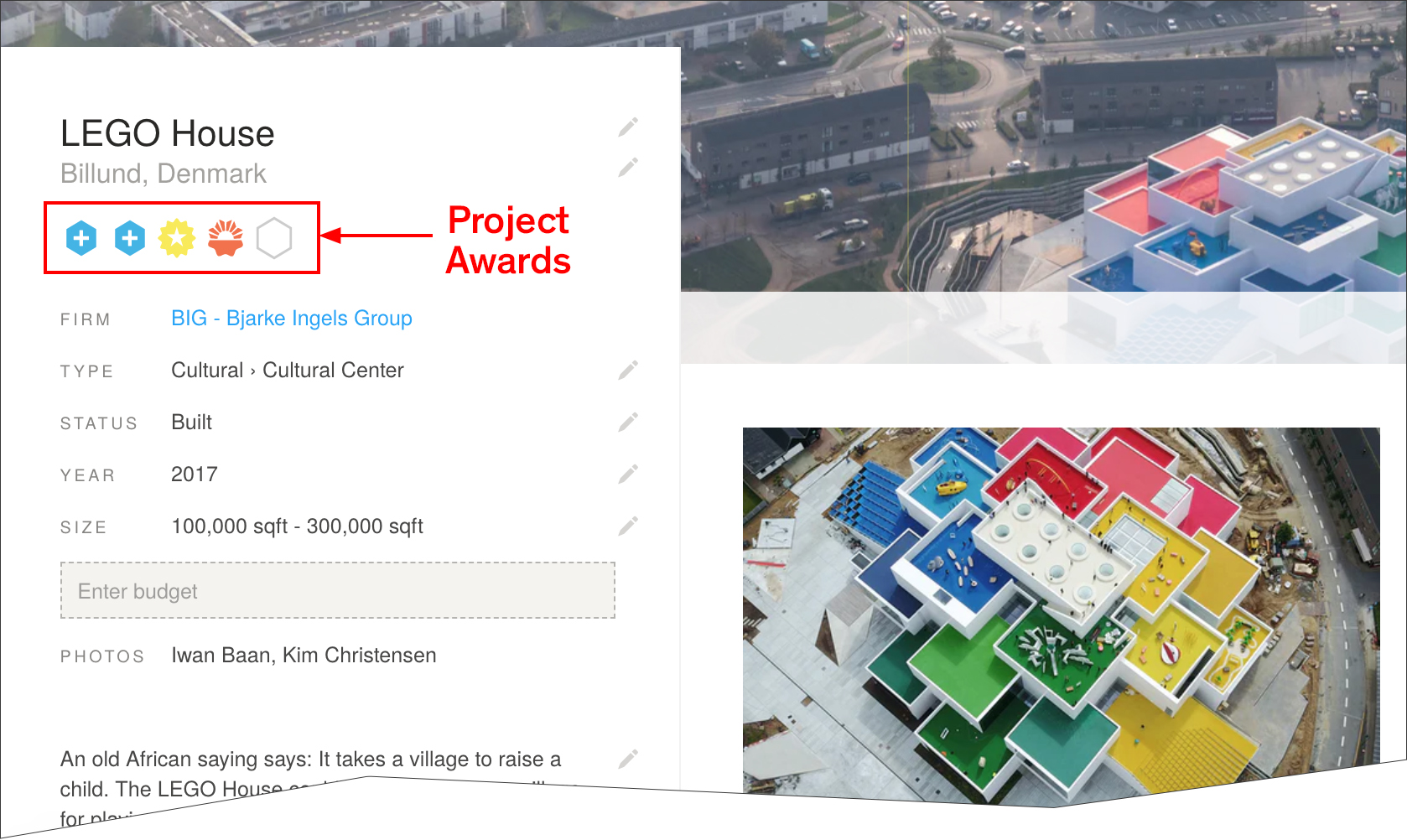
An example of a project page on Architizer with Project Award Badges highlighted
A Guide to Project Awards
The blue “+” badge denotes that a project has won a prestigious A+Award as described above. Hovering over the badge reveals details of the award, including award category, year, and whether the project won the jury or popular choice award.
The orange Project of the Day and yellow Featured Project badges are awarded by Architizer’s Editorial team, and are selected based on a number of factors. The following factors increase a project’s likelihood of being featured or awarded Project of the Day status:
- Project completed within the last 3 years
- A well written, concise project description of at least 3 paragraphs
- Architectural design with a high level of both functional and aesthetic value
- High quality, in focus photographs
- At least 8 photographs of both the interior and exterior of the building
- Inclusion of architectural drawings and renderings
- Inclusion of construction photographs
There are 7 Projects of the Day each week and a further 31 Featured Projects. Each Project of the Day is published on Facebook, Twitter and Instagram Stories, while each Featured Project is published on Facebook. Each Project of the Day also features in Architizer’s Weekly Projects Newsletter and shared with 170,000 subscribers.
We’re constantly look for the world’s best architects to join our community. If you would like to understand more about this ranking list and learn how your firm can achieve a presence on it, please don’t hesitate to reach out to us at editorial@architizer.com.
The post 30 Best Architecture and Design Firms in Iran appeared first on Journal.

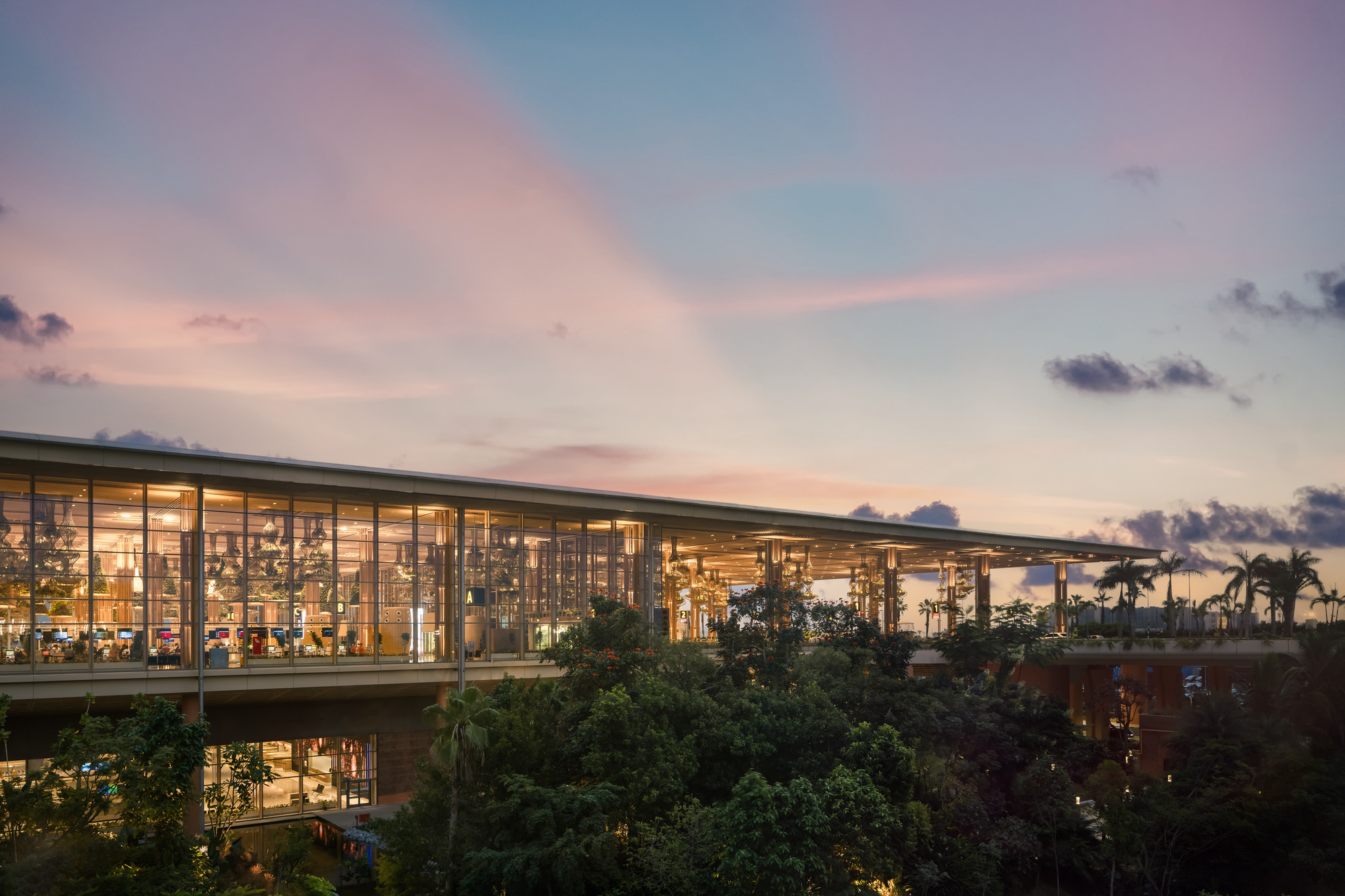
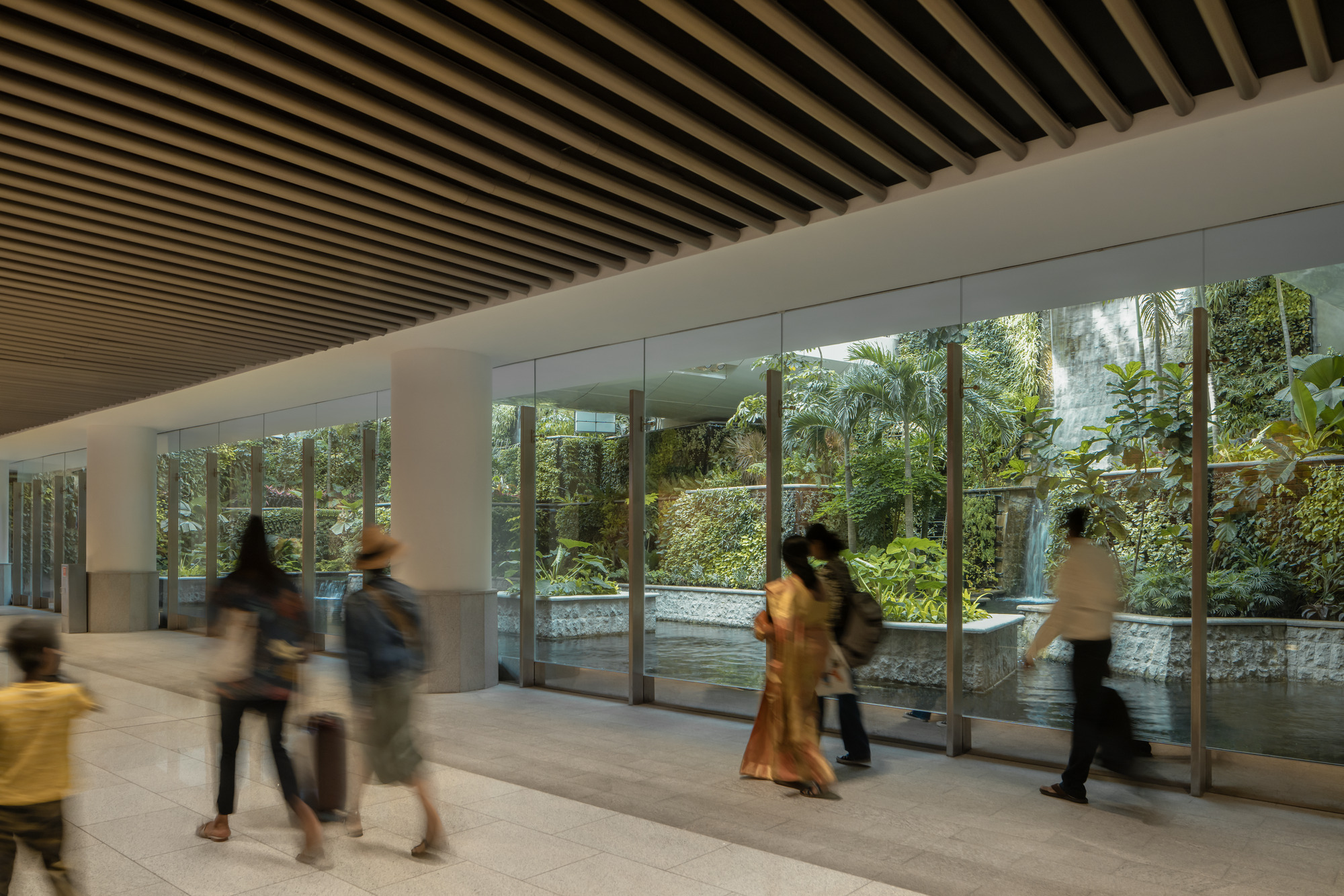
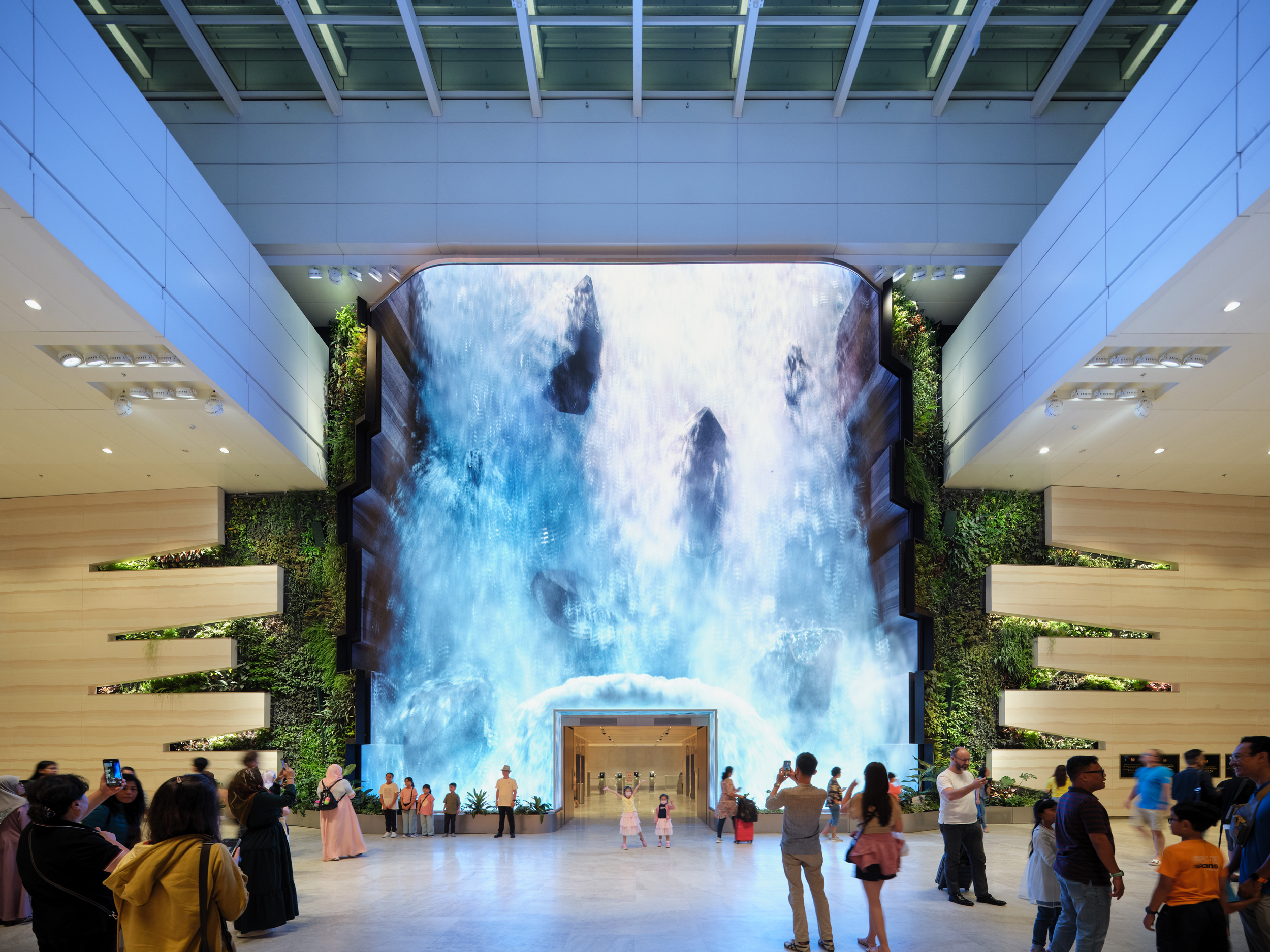
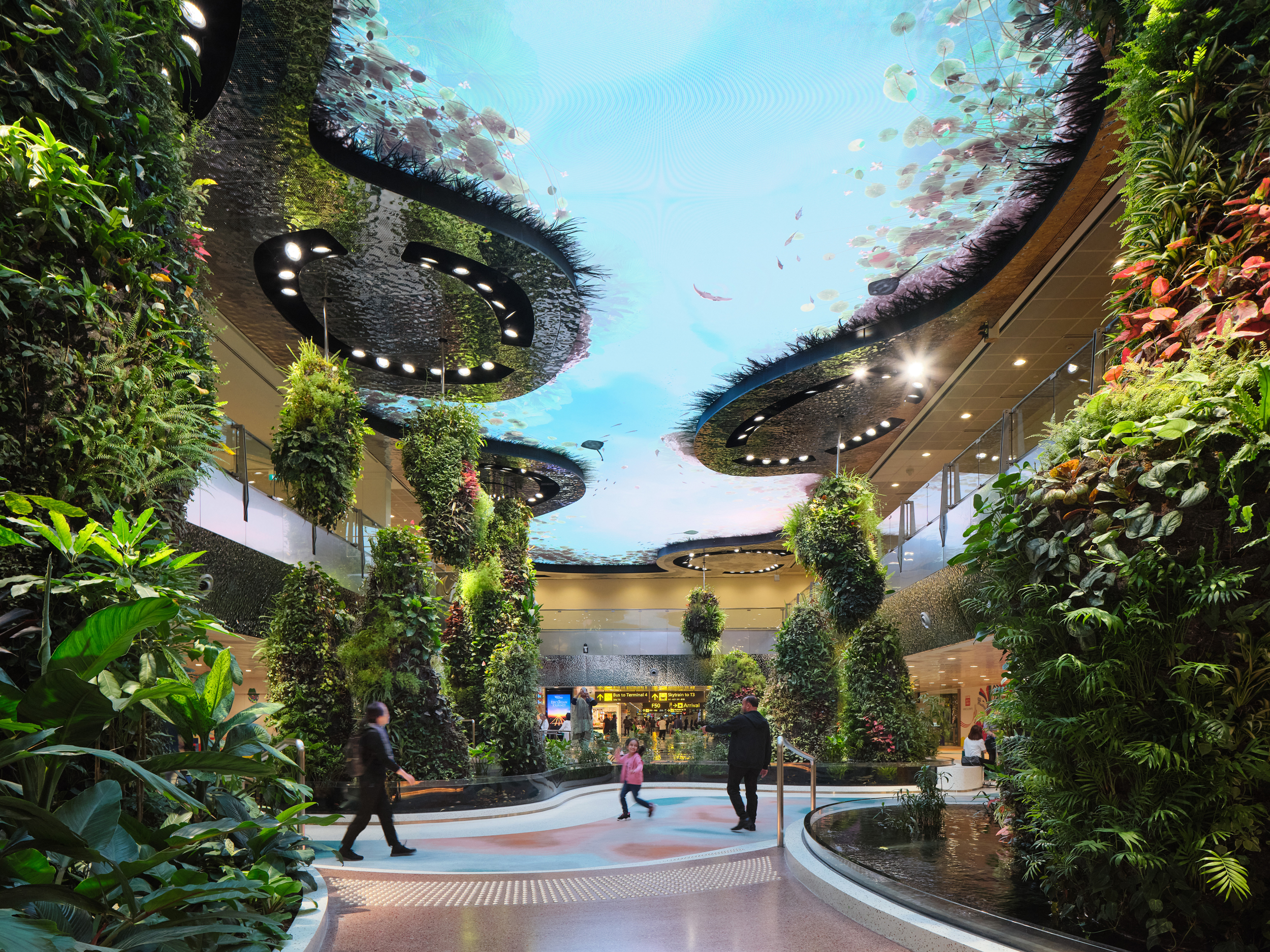
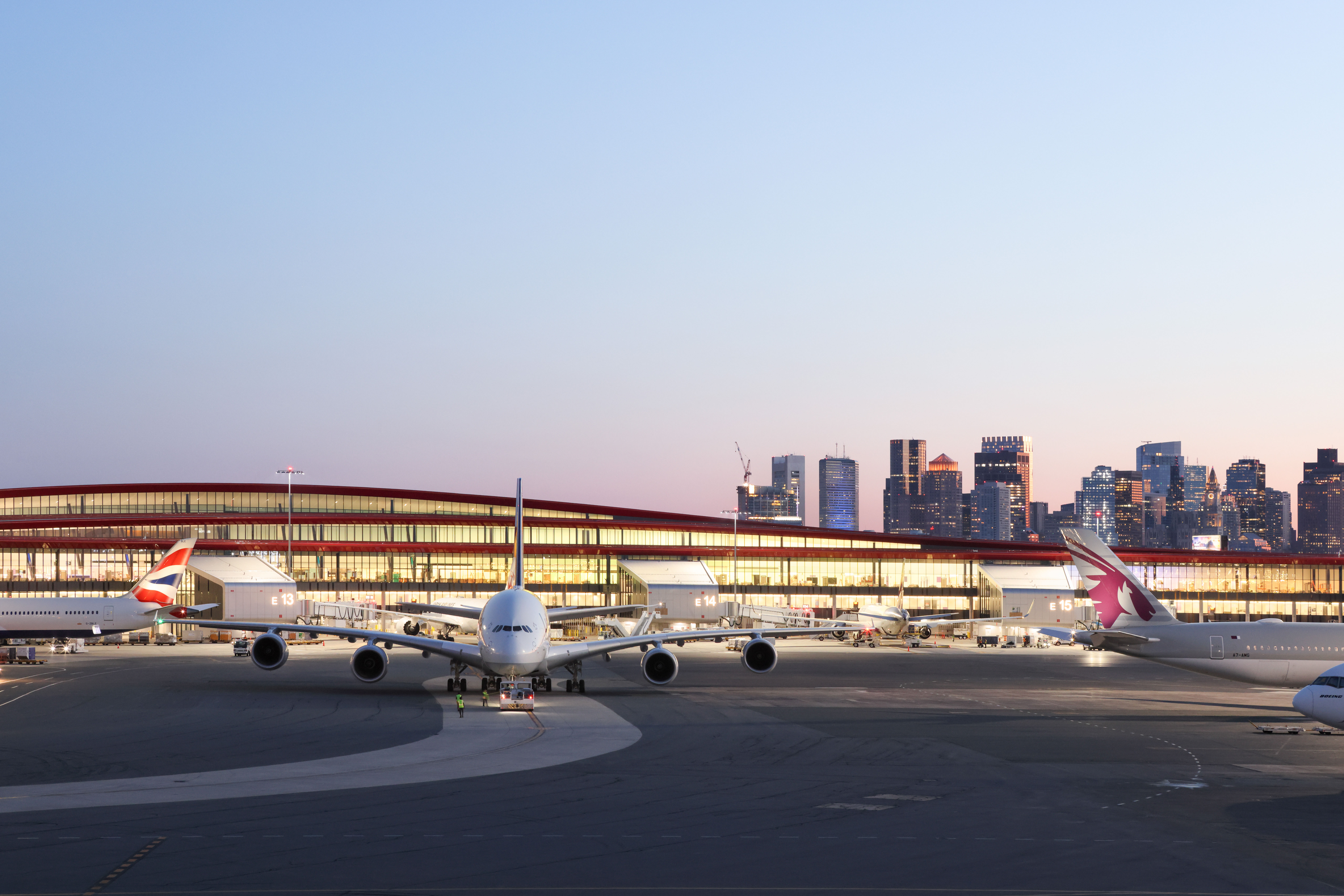

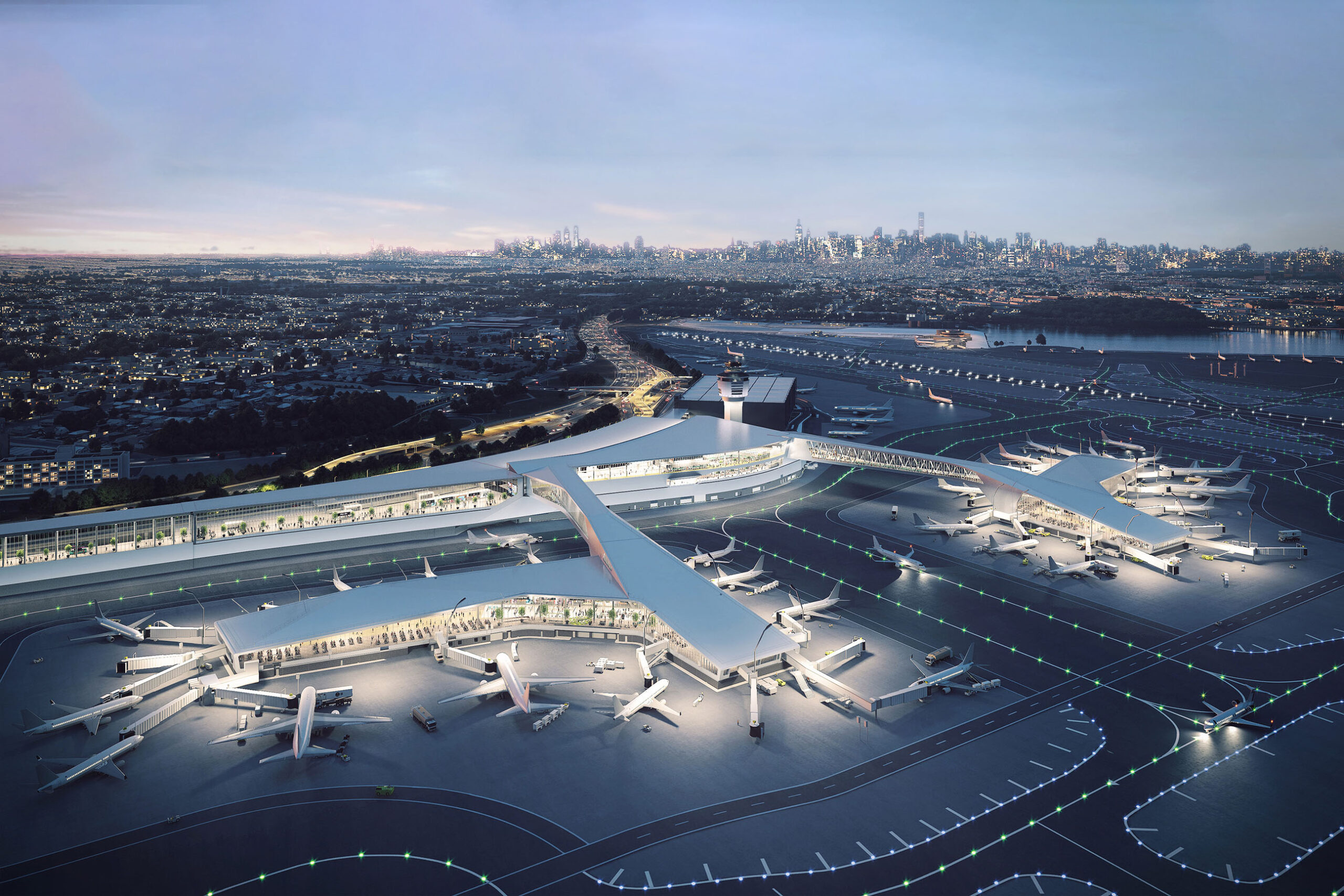
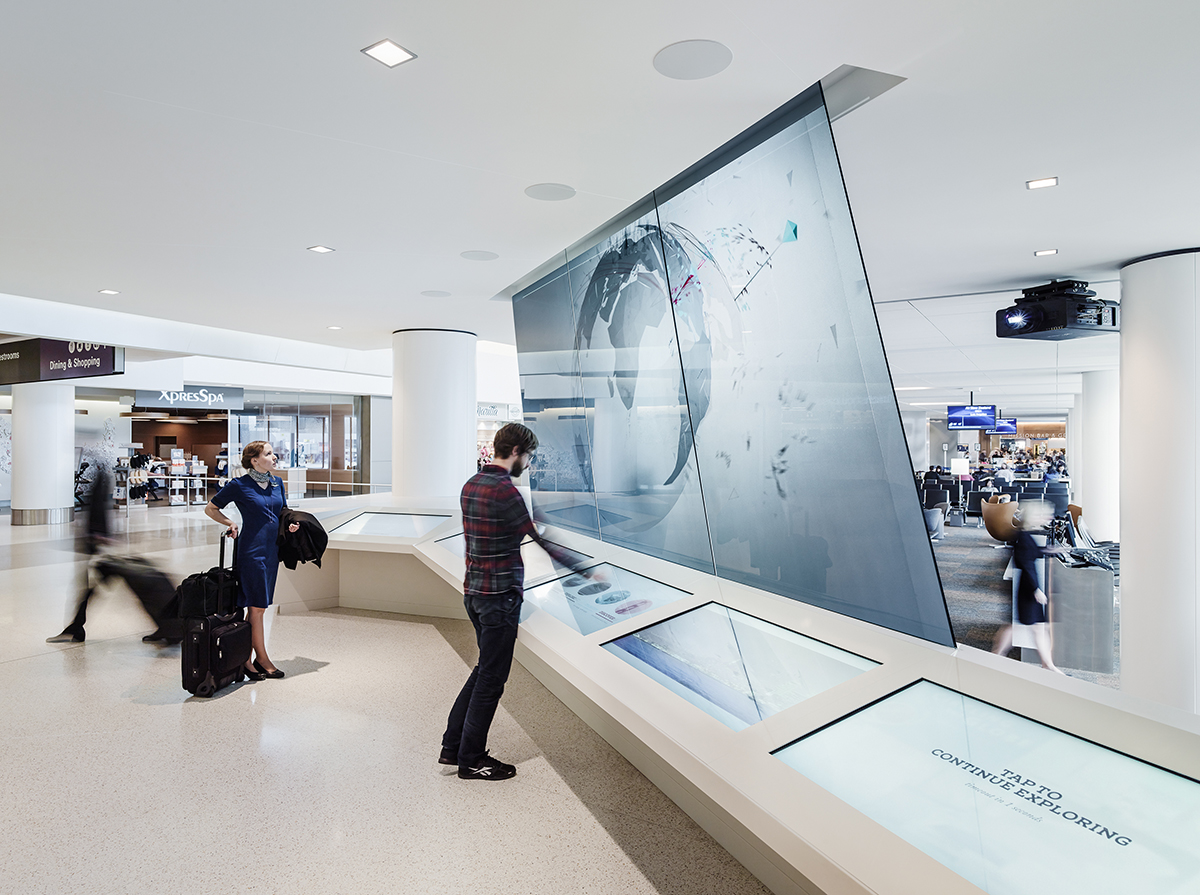
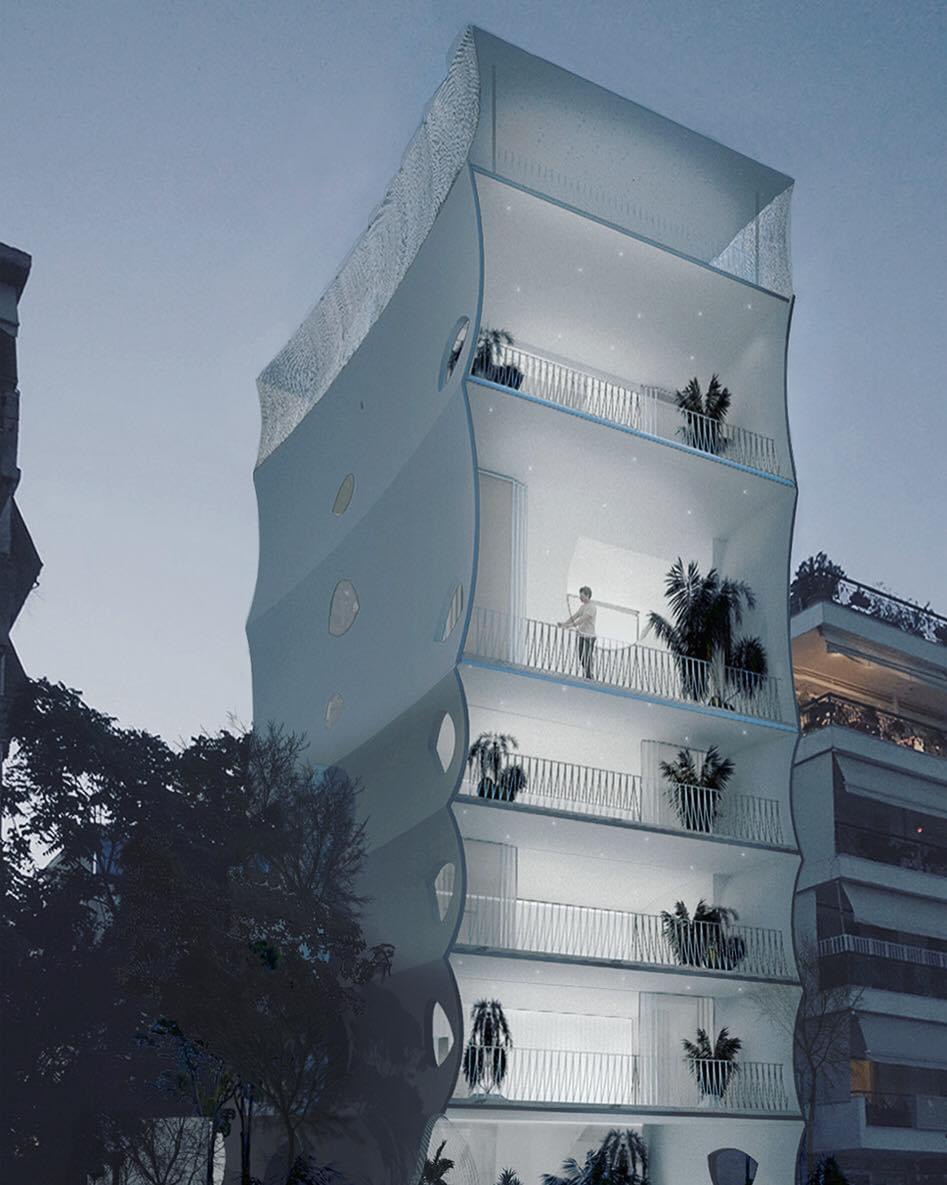
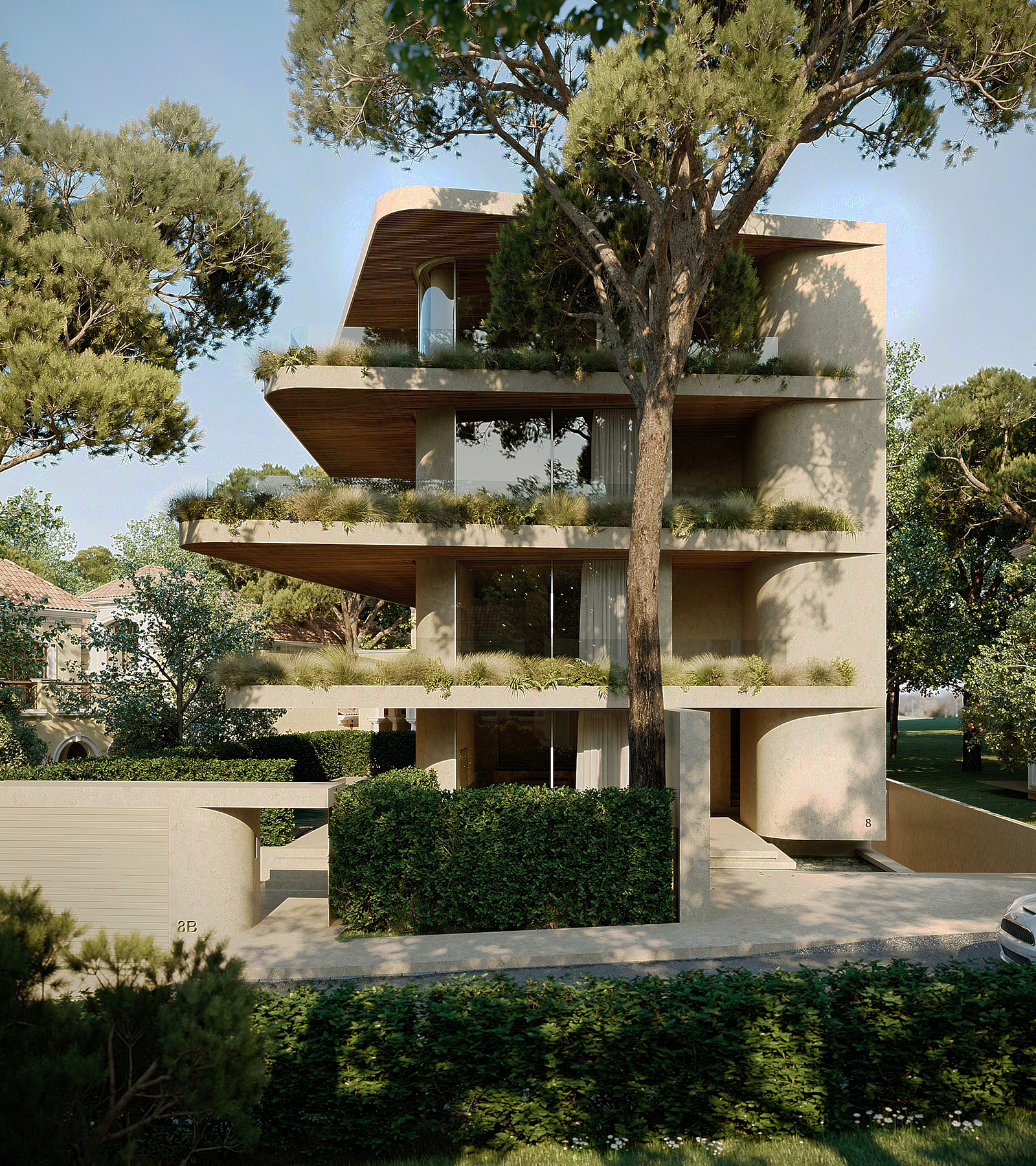

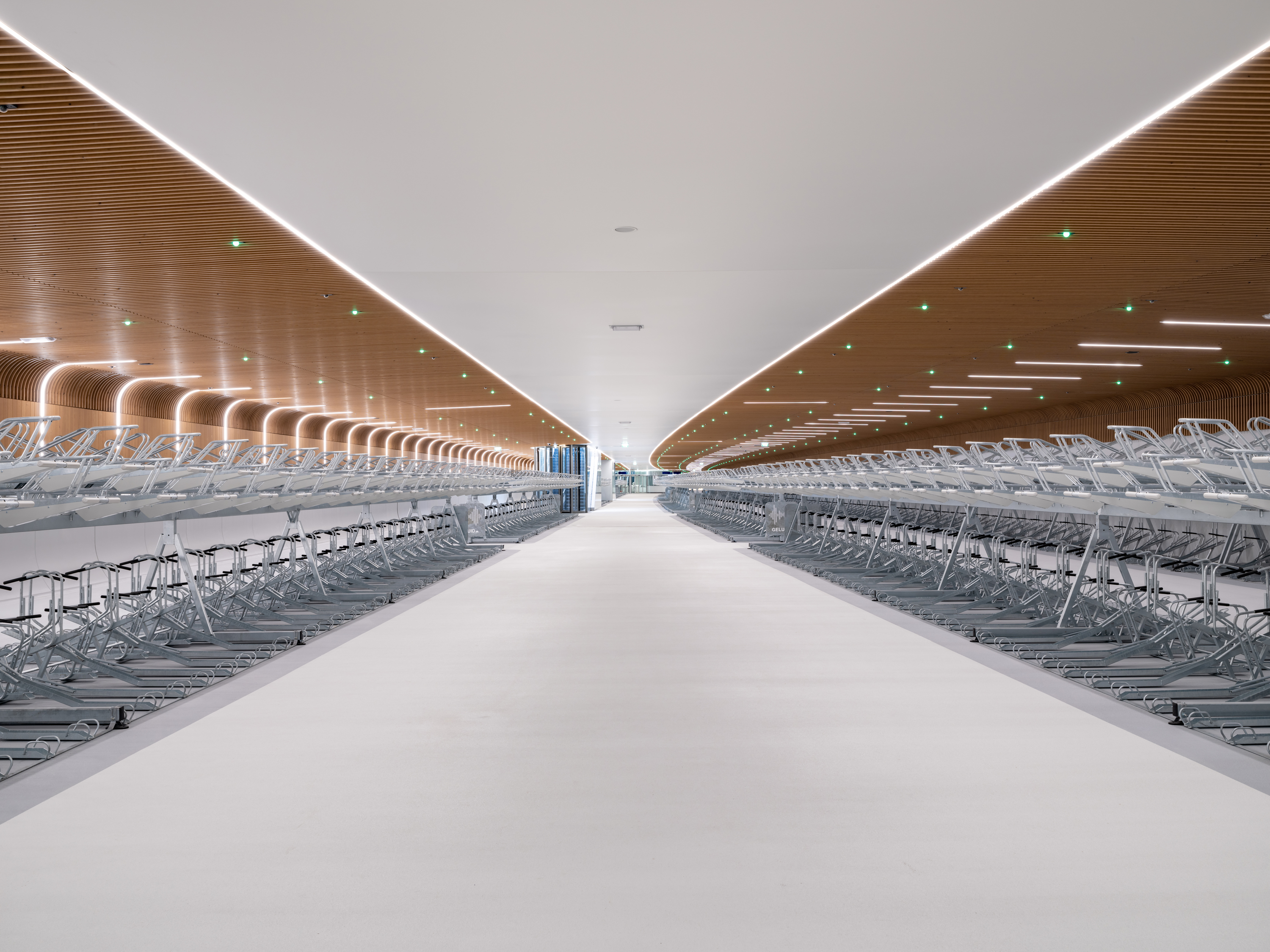


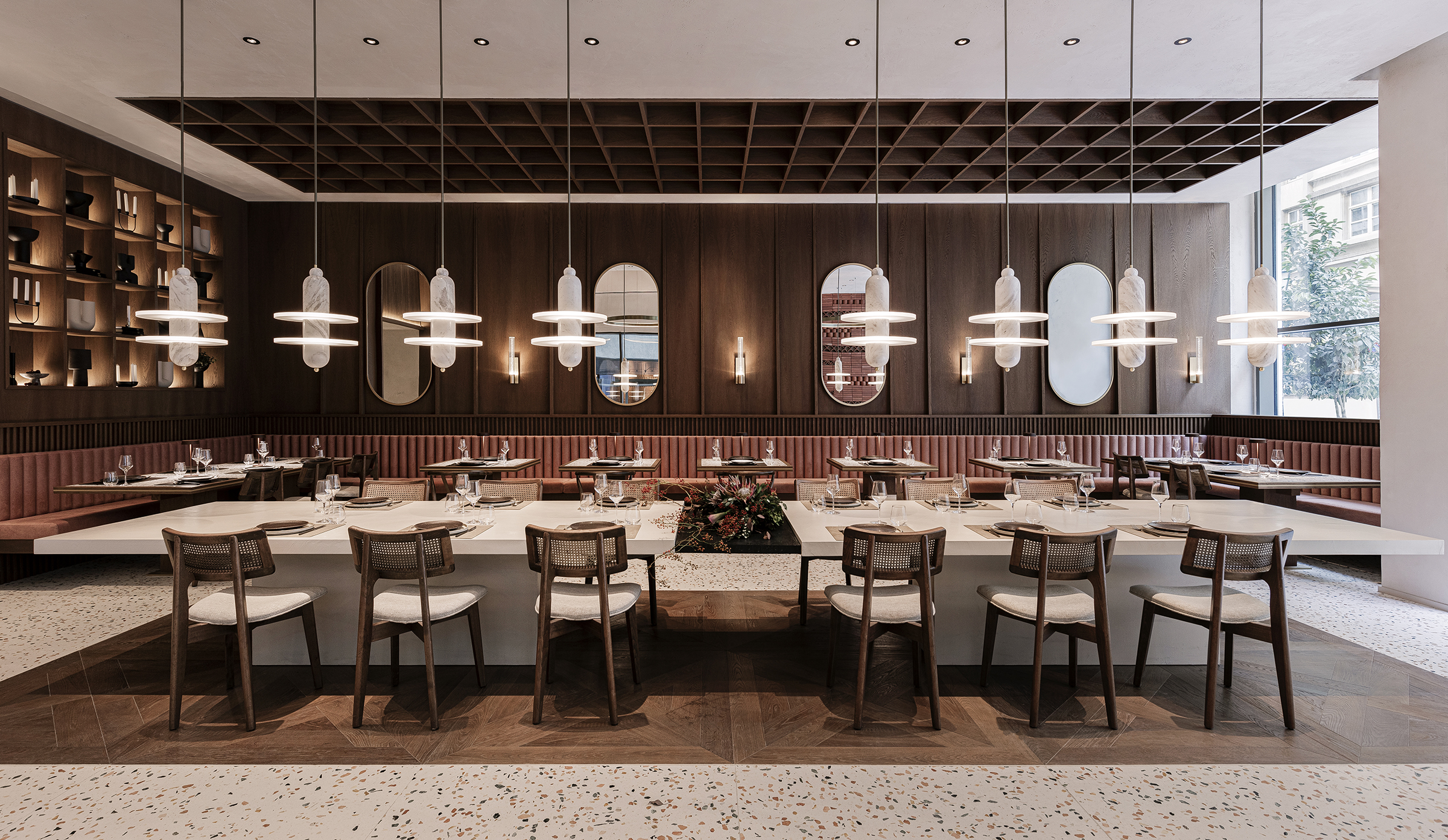 Monasty’s interior design merges the Byzantine heritage of Thessaloniki with the luxury of the Autograph Collection by Marriott. Drawing inspiration from the city’s rich history and its surviving Christian Orthodox temples, the hotel offers a mystical atmosphere. Its 100 rooms and common spaces feature an austere materiality, subtle lighting and a monastic aesthetic that balances the high-end amenities of a 5-star hotel.
Monasty’s interior design merges the Byzantine heritage of Thessaloniki with the luxury of the Autograph Collection by Marriott. Drawing inspiration from the city’s rich history and its surviving Christian Orthodox temples, the hotel offers a mystical atmosphere. Its 100 rooms and common spaces feature an austere materiality, subtle lighting and a monastic aesthetic that balances the high-end amenities of a 5-star hotel.
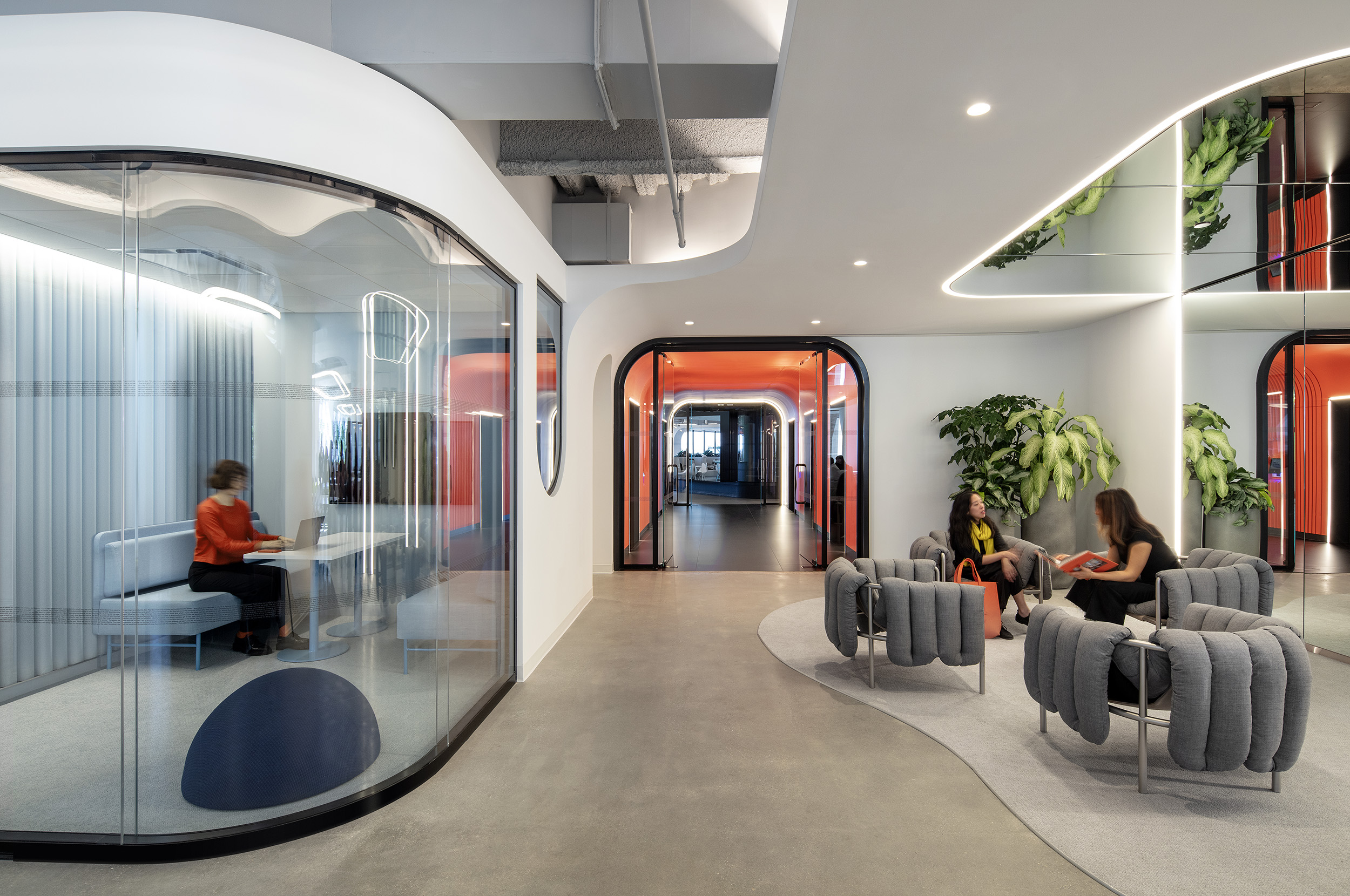

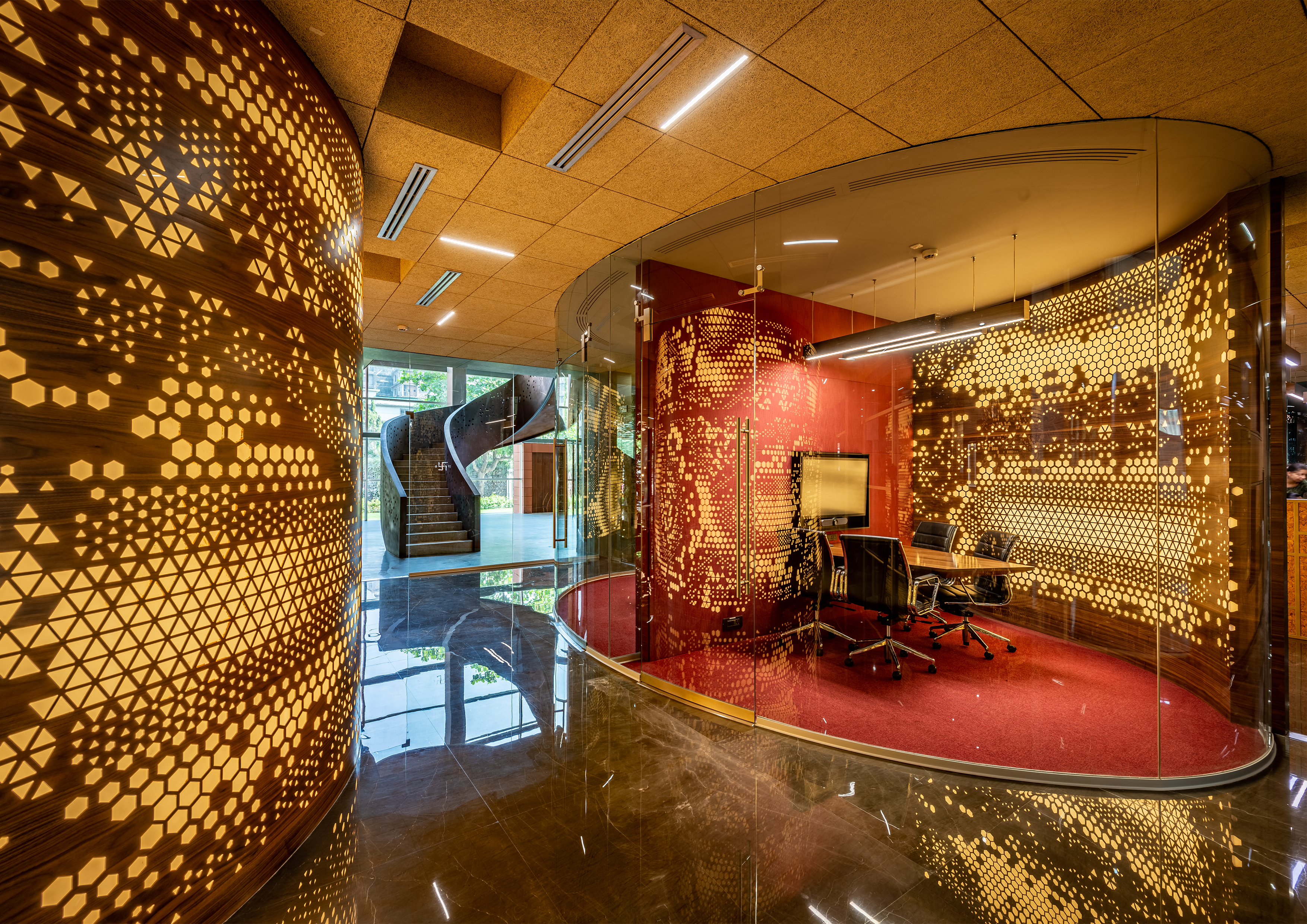
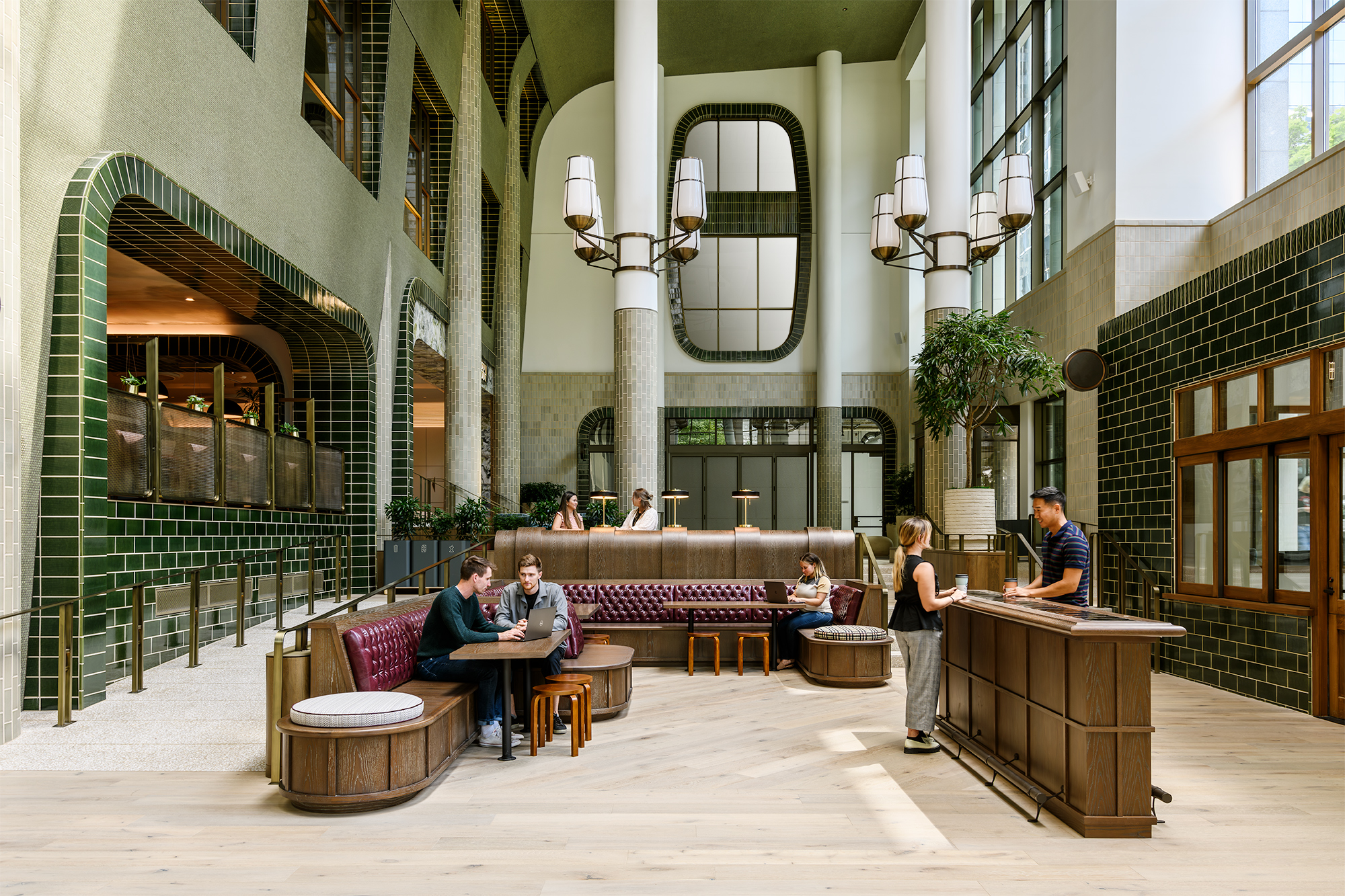
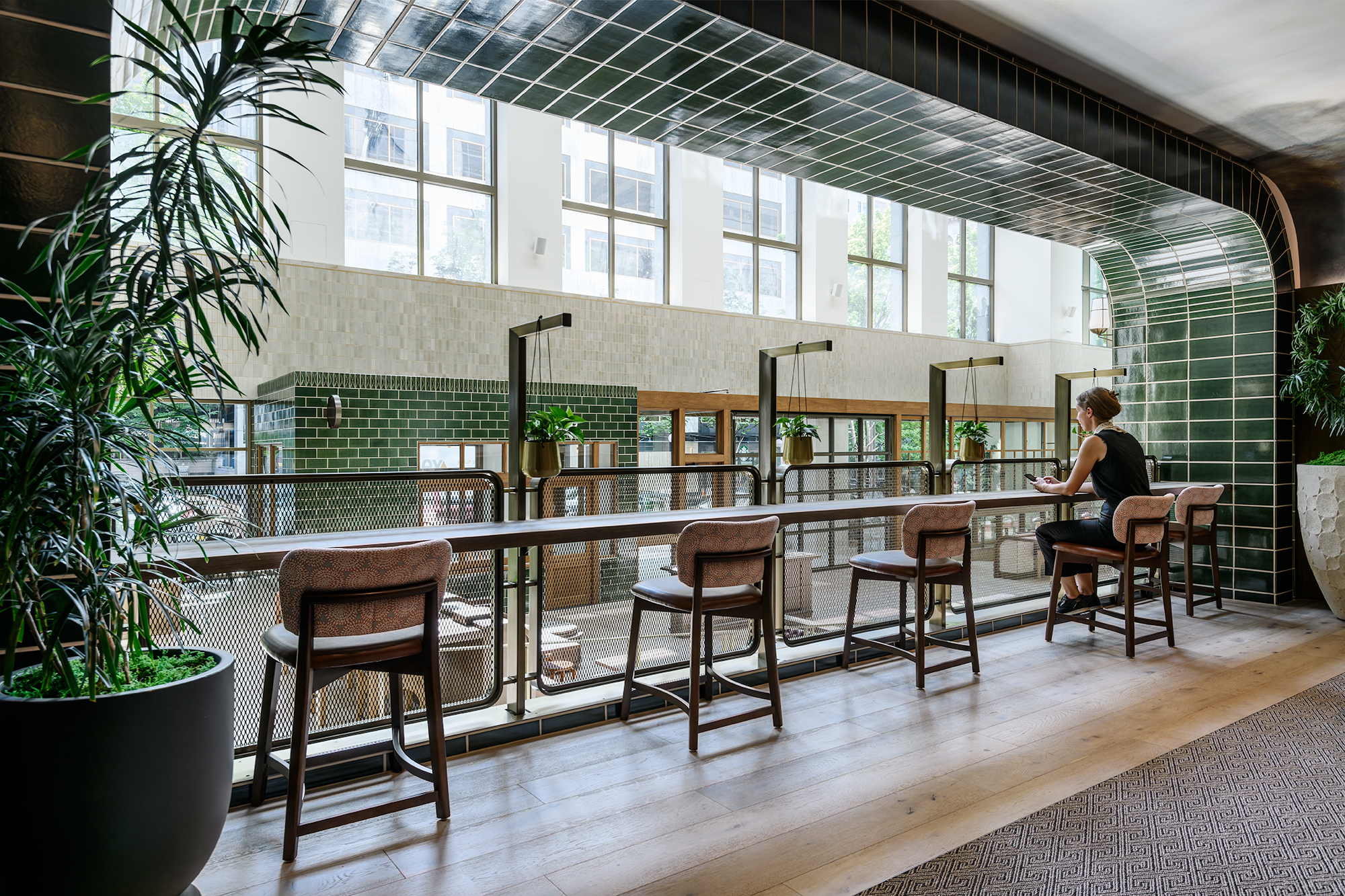 The revitalization of the 44-story U.S. Bank Center transforms the iconic building into a vibrant workplace and welcoming public space. At its heart, Cedar Hall replaces the previously cramped atrium with an open, inviting expanse featuring 3.6 million green penny tiles that reflect sunlight. Operable doors, accessible seating, and dynamic indoor streetscapes foster connection, while the Tower Lobby guides visitors through curated art and adaptable settings.
The revitalization of the 44-story U.S. Bank Center transforms the iconic building into a vibrant workplace and welcoming public space. At its heart, Cedar Hall replaces the previously cramped atrium with an open, inviting expanse featuring 3.6 million green penny tiles that reflect sunlight. Operable doors, accessible seating, and dynamic indoor streetscapes foster connection, while the Tower Lobby guides visitors through curated art and adaptable settings.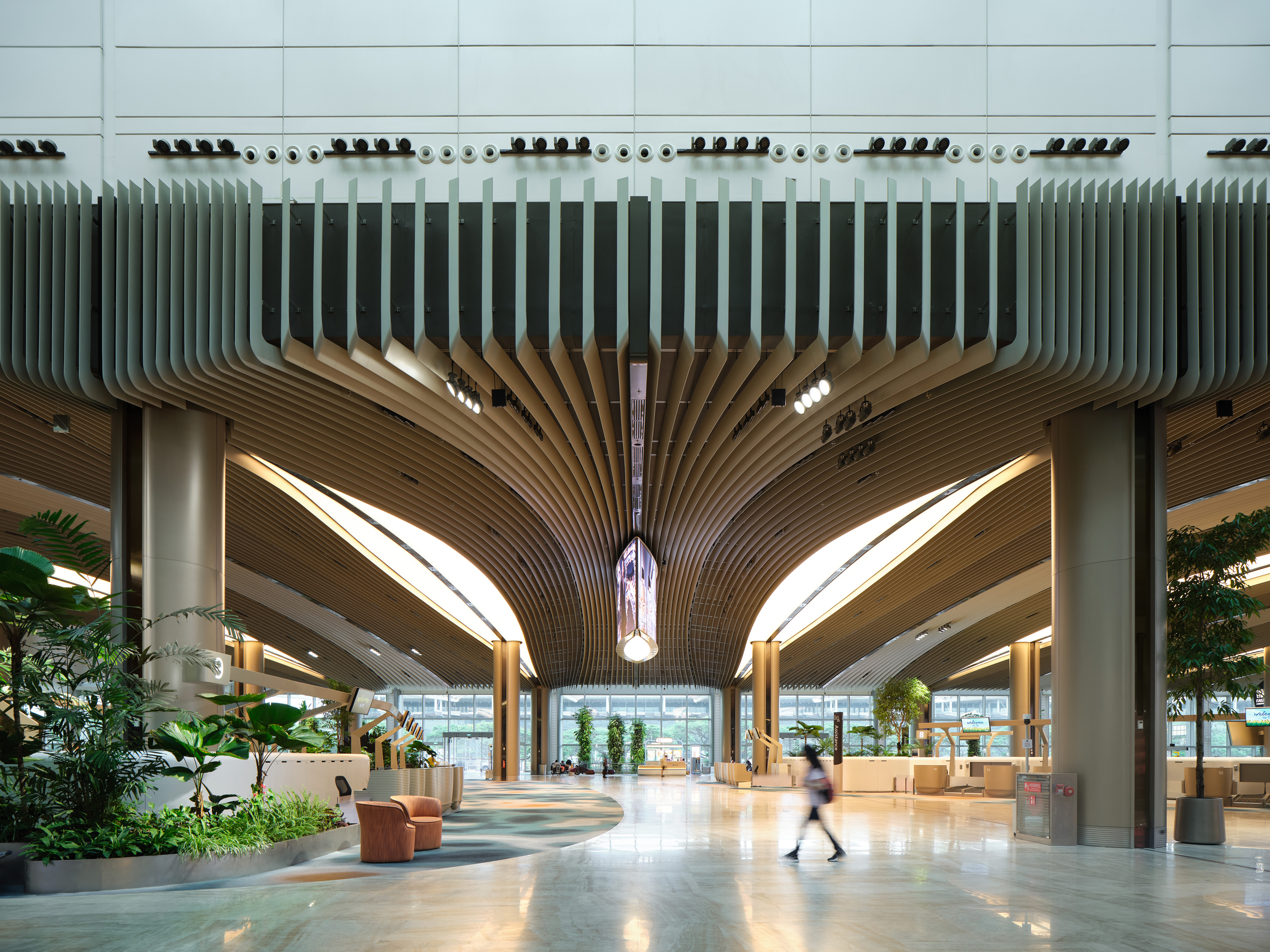
 The expansion and renovation of Terminal 2 at Singapore’s Changi Airport spans across three levels, with a design prioritizing the traveler experience through calming visual, auditory, and interactive elements. Inspired by nature, the terminal features indoor landscapes with minerals, water features, and lush vegetation to create a serene, multi-sensory environment.
The expansion and renovation of Terminal 2 at Singapore’s Changi Airport spans across three levels, with a design prioritizing the traveler experience through calming visual, auditory, and interactive elements. Inspired by nature, the terminal features indoor landscapes with minerals, water features, and lush vegetation to create a serene, multi-sensory environment.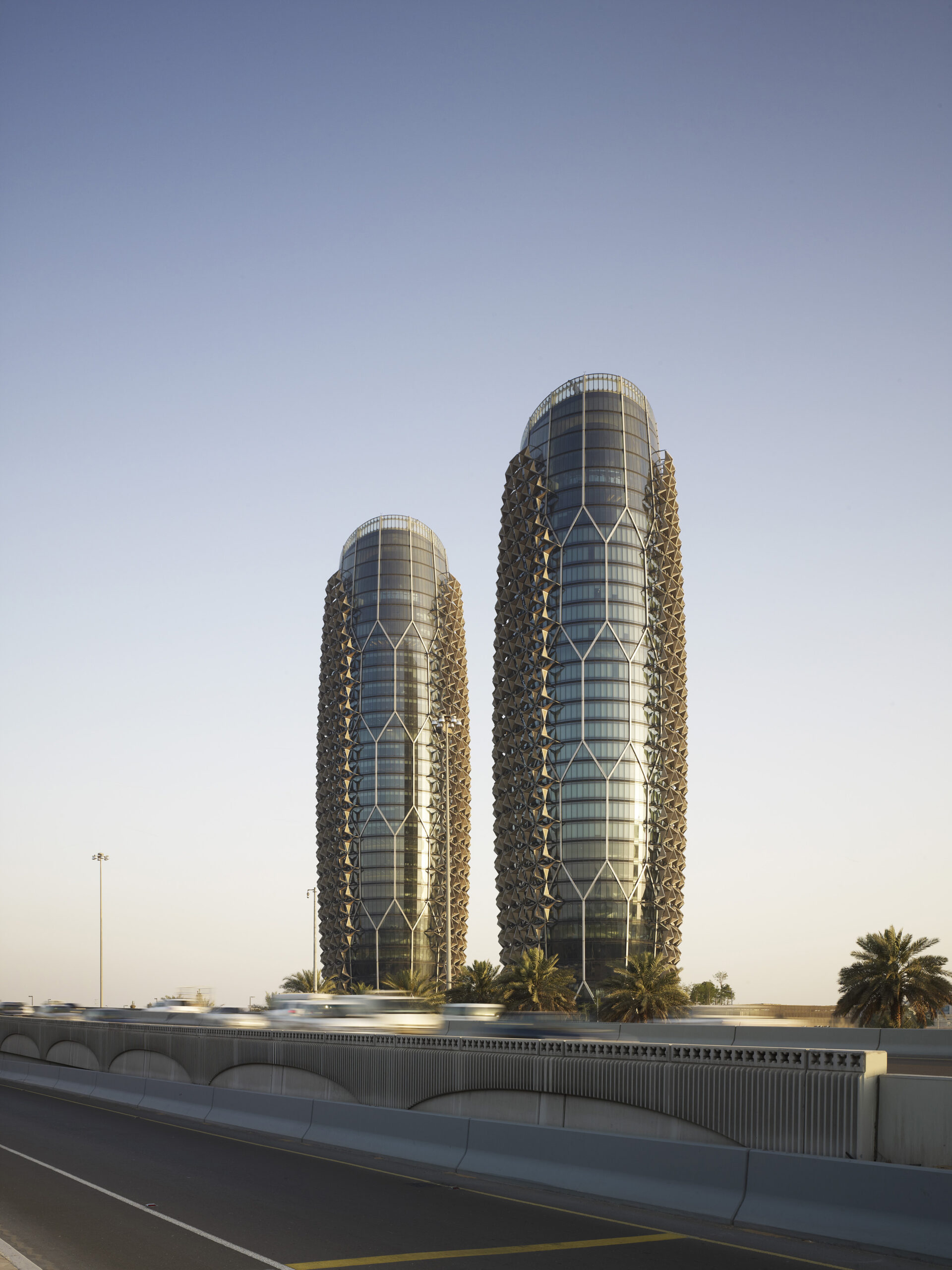



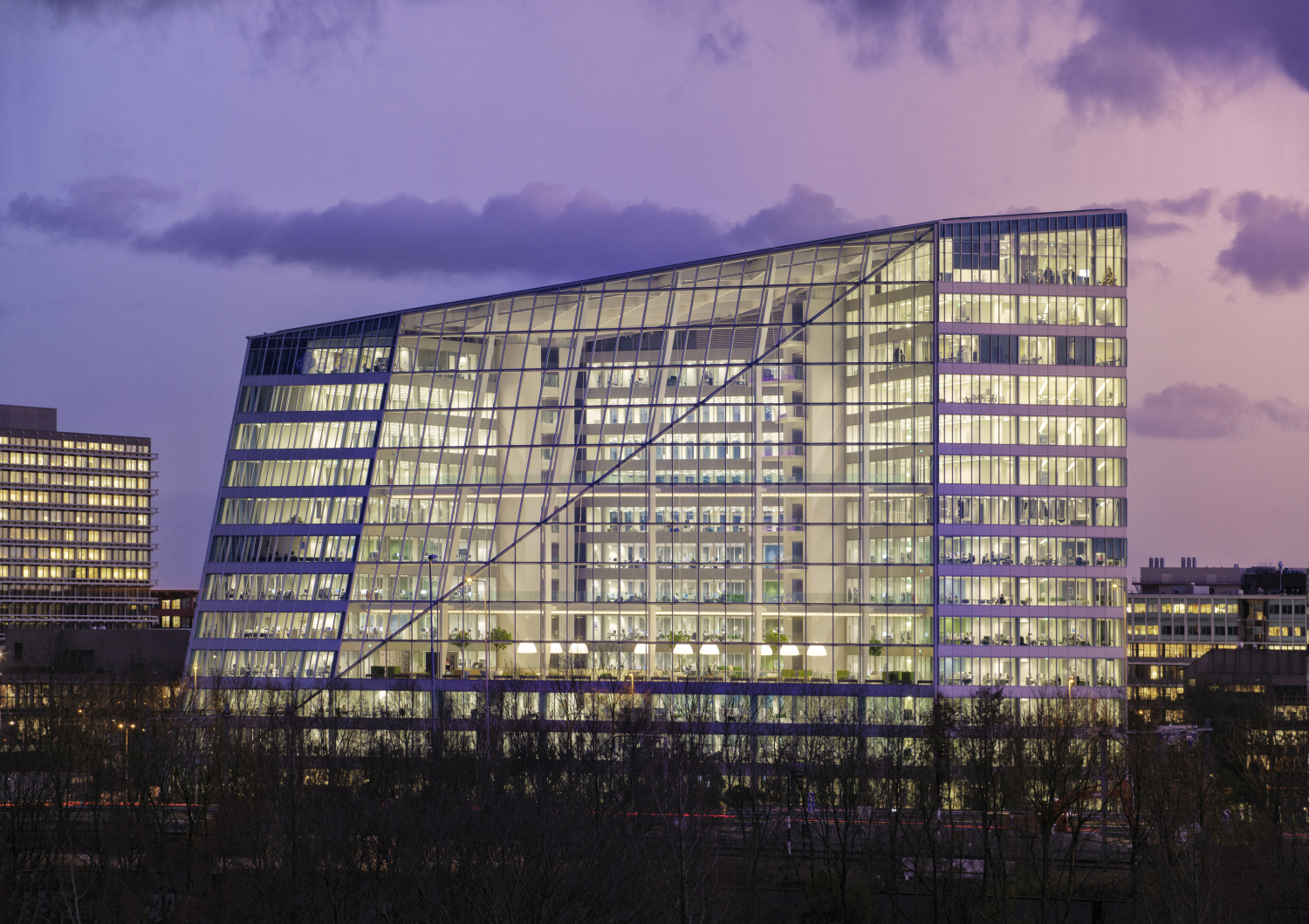
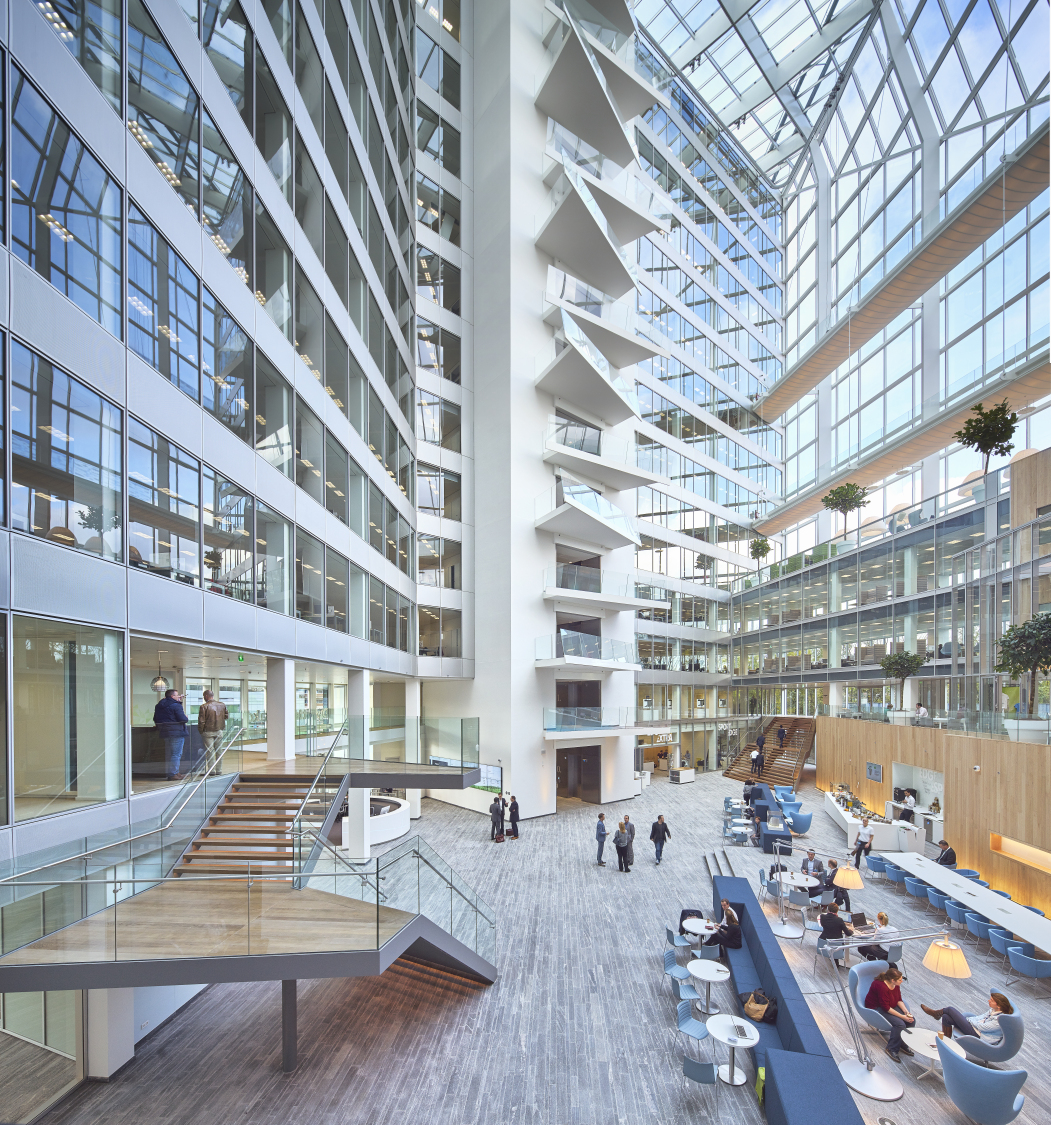
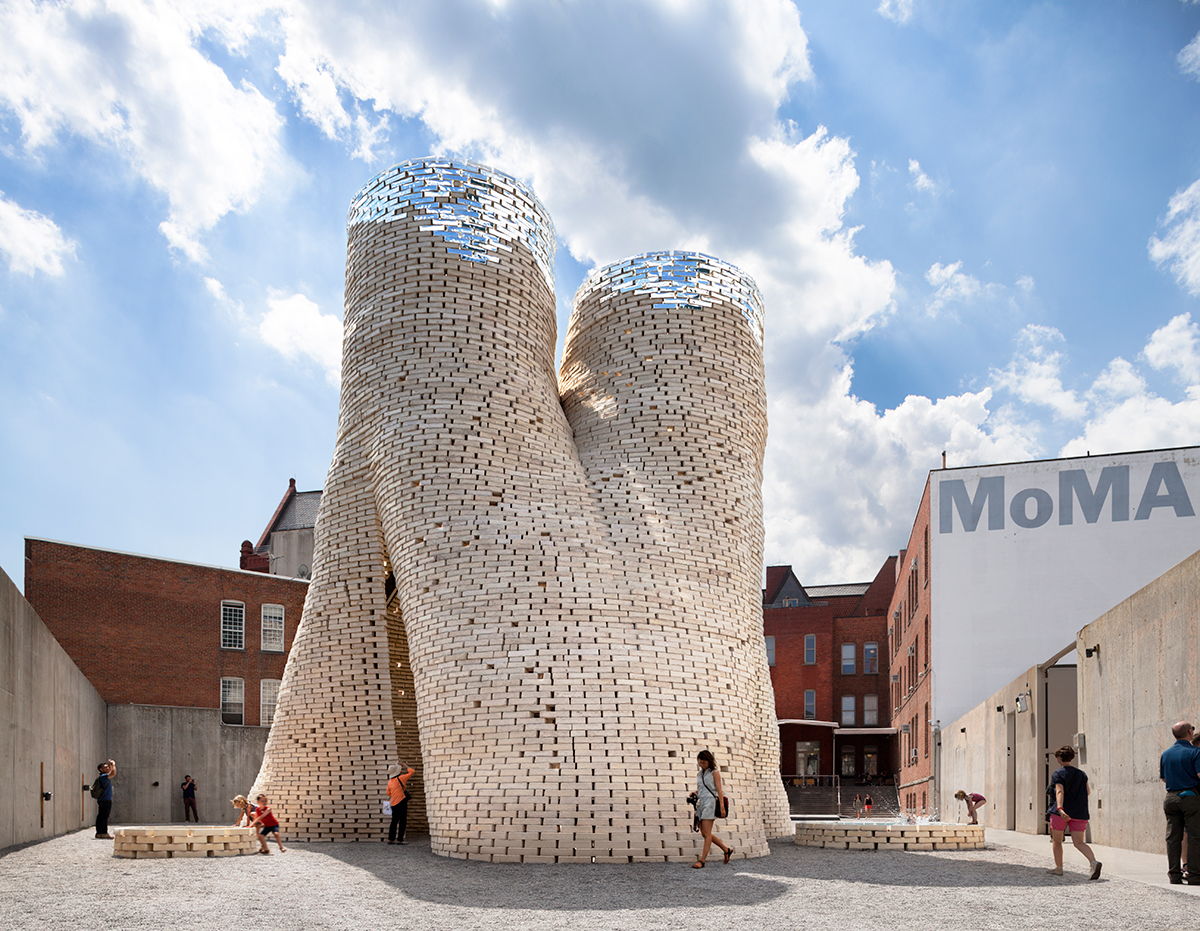































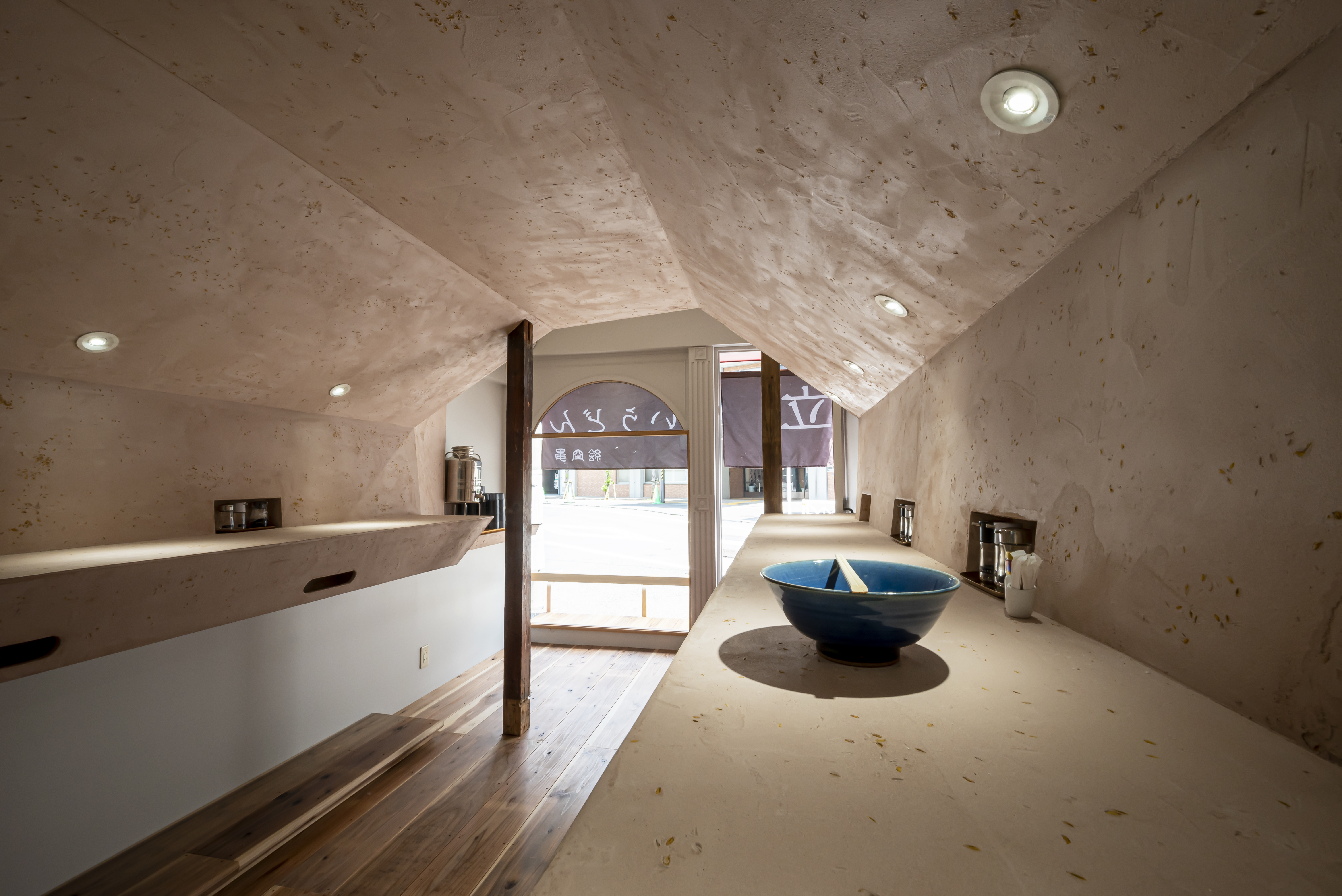

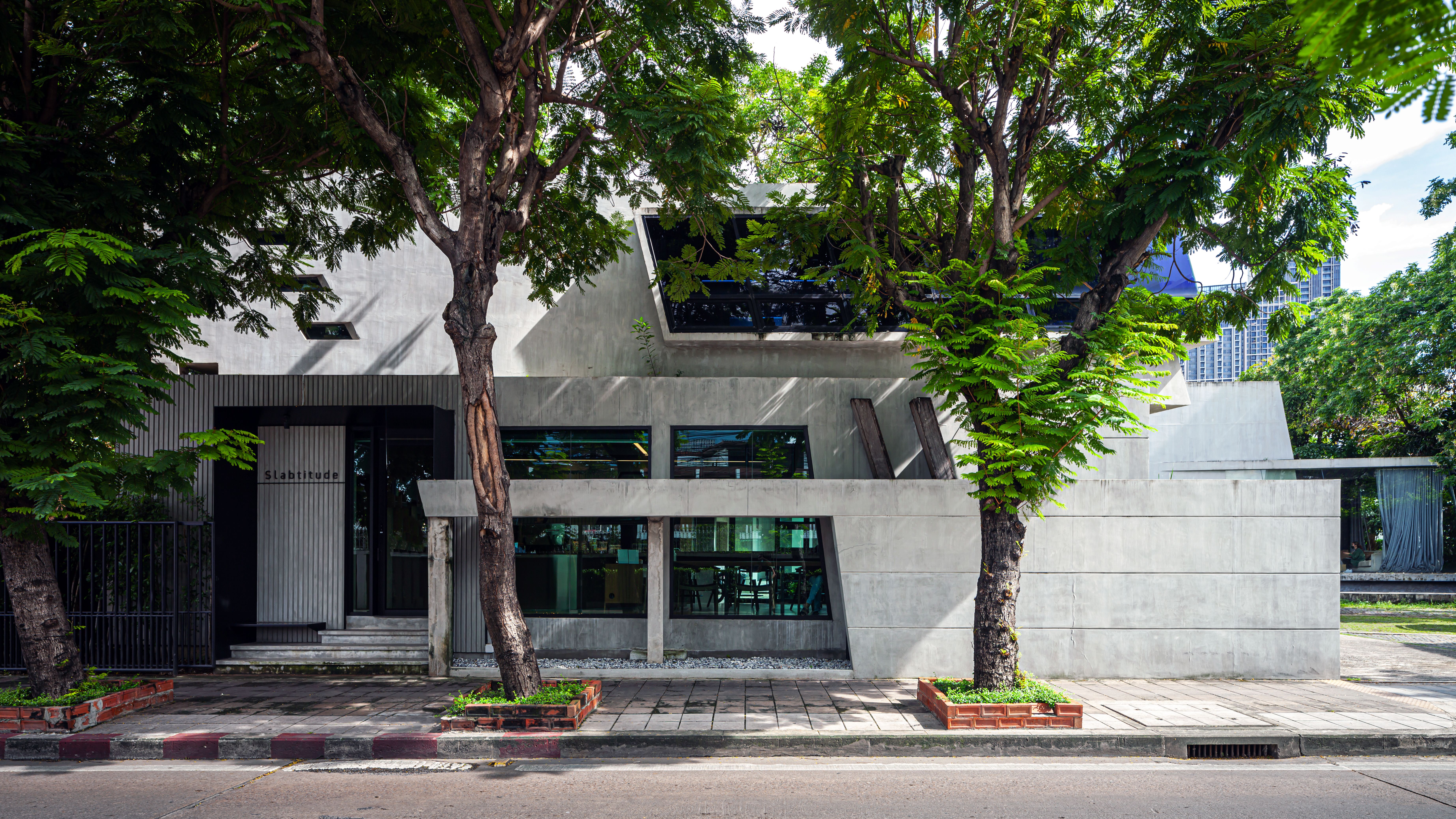
 Slabtitude, a cafe created by Vaslab, emerged from the firm’s idea of revamping the storage space in front of their office into a place where staff could casually meet, work or relax over coffee. The cafe’s design features exposed concrete surfaces and a striking, 23-foot-long (7-meter) Balau wood table, crafted in collaboration with Thick and Thin Studio.
Slabtitude, a cafe created by Vaslab, emerged from the firm’s idea of revamping the storage space in front of their office into a place where staff could casually meet, work or relax over coffee. The cafe’s design features exposed concrete surfaces and a striking, 23-foot-long (7-meter) Balau wood table, crafted in collaboration with Thick and Thin Studio.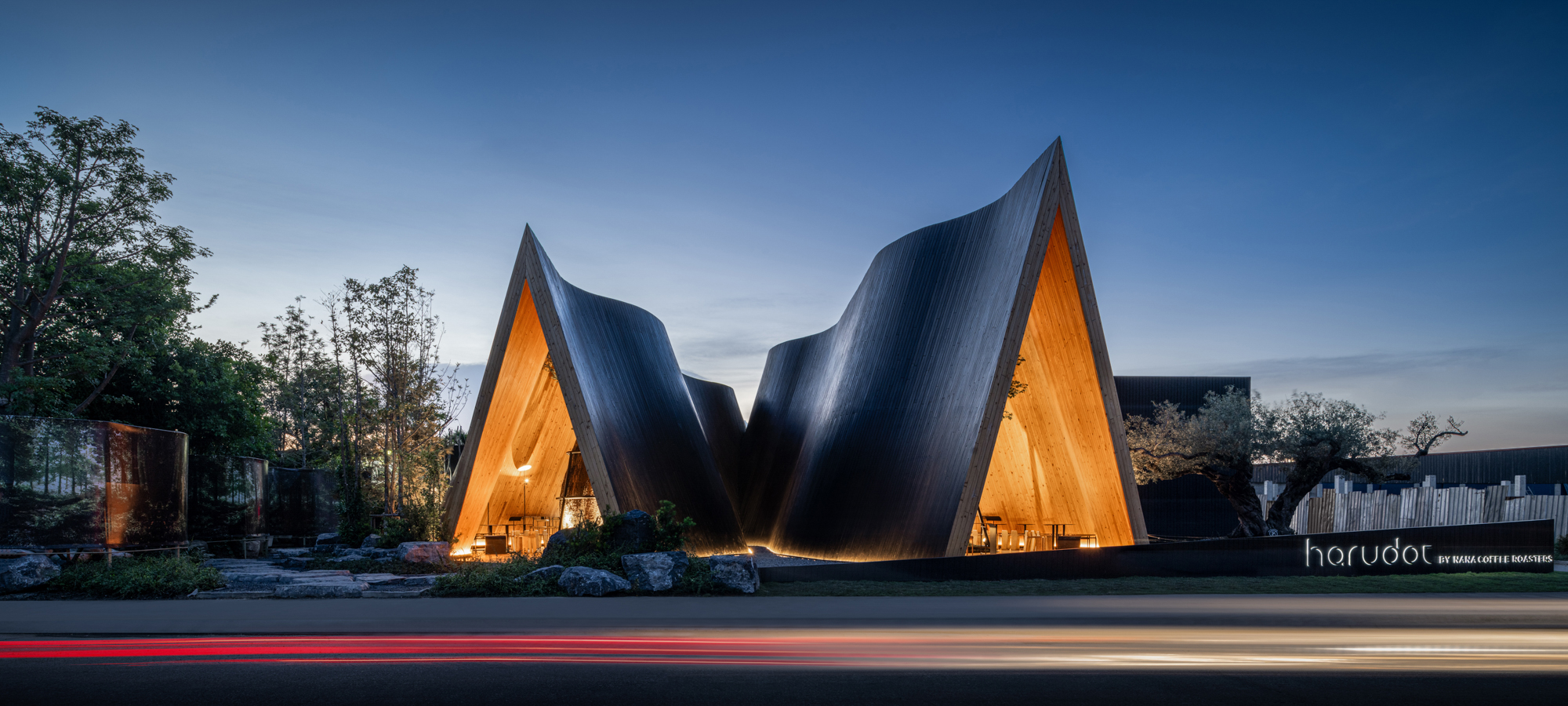
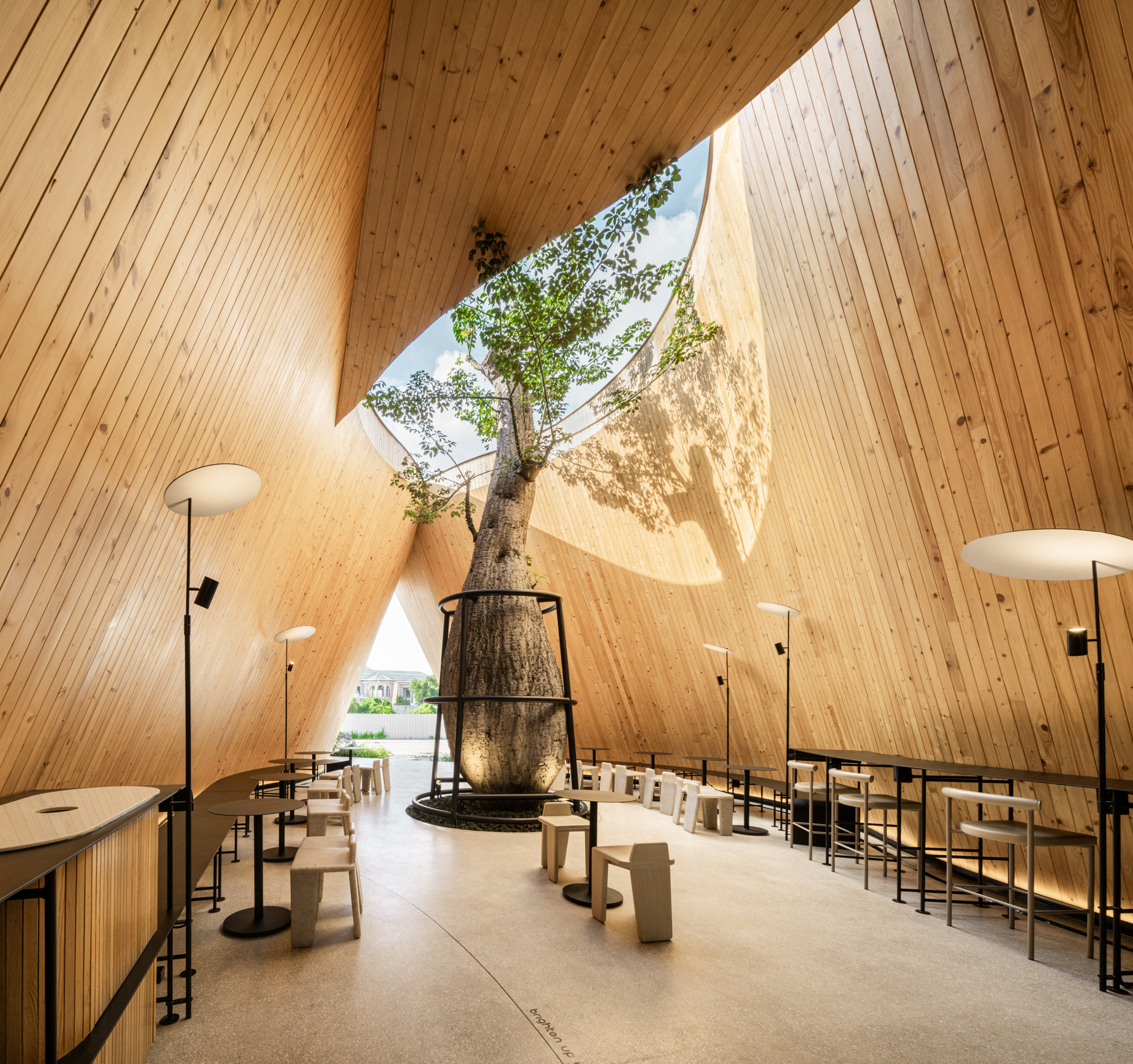
 Harudot is a unique café in Chonburi, Thailand, resulting from a collaboration between Nana Coffee Roasters and a plant-loving landlord. The café, named “Haru” (Spring) and “Dot” (Starting Point), is designed to be a destination that blends new beginnings with growth, featuring a central baobab tree in an inner courtyard where the architecture opens to the sky. Inspired by Japanese culture’s simplicity, the exterior boasts three black gable forms contrasting with warm pine wood interiors.
Harudot is a unique café in Chonburi, Thailand, resulting from a collaboration between Nana Coffee Roasters and a plant-loving landlord. The café, named “Haru” (Spring) and “Dot” (Starting Point), is designed to be a destination that blends new beginnings with growth, featuring a central baobab tree in an inner courtyard where the architecture opens to the sky. Inspired by Japanese culture’s simplicity, the exterior boasts three black gable forms contrasting with warm pine wood interiors.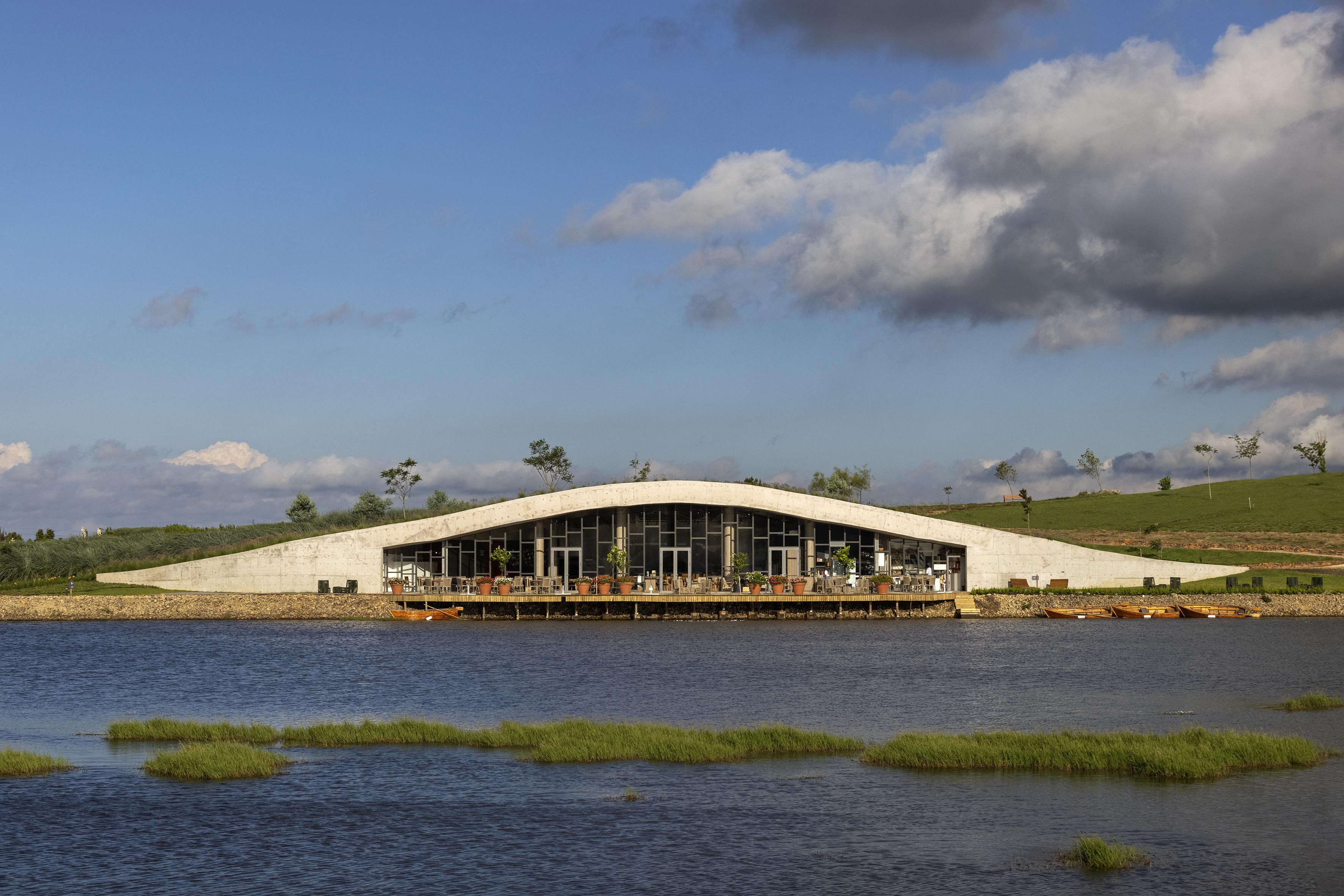
 Set in the picturesque landscape of Rio Grande do Sul, the Restaurant by the Lake is designed to offer visitors a memorable dining experience with stunning views. The challenge was to create architecture that enhances, rather than competes with, the natural beauty of the environment. The restaurant’s cave-like design, with its concave-convex structure, seamlessly blends into the gentle elevations and slopes of the terrain. In turn, it harmoniously integrates with the landscape to create a discreet and immersive experience.
Set in the picturesque landscape of Rio Grande do Sul, the Restaurant by the Lake is designed to offer visitors a memorable dining experience with stunning views. The challenge was to create architecture that enhances, rather than competes with, the natural beauty of the environment. The restaurant’s cave-like design, with its concave-convex structure, seamlessly blends into the gentle elevations and slopes of the terrain. In turn, it harmoniously integrates with the landscape to create a discreet and immersive experience.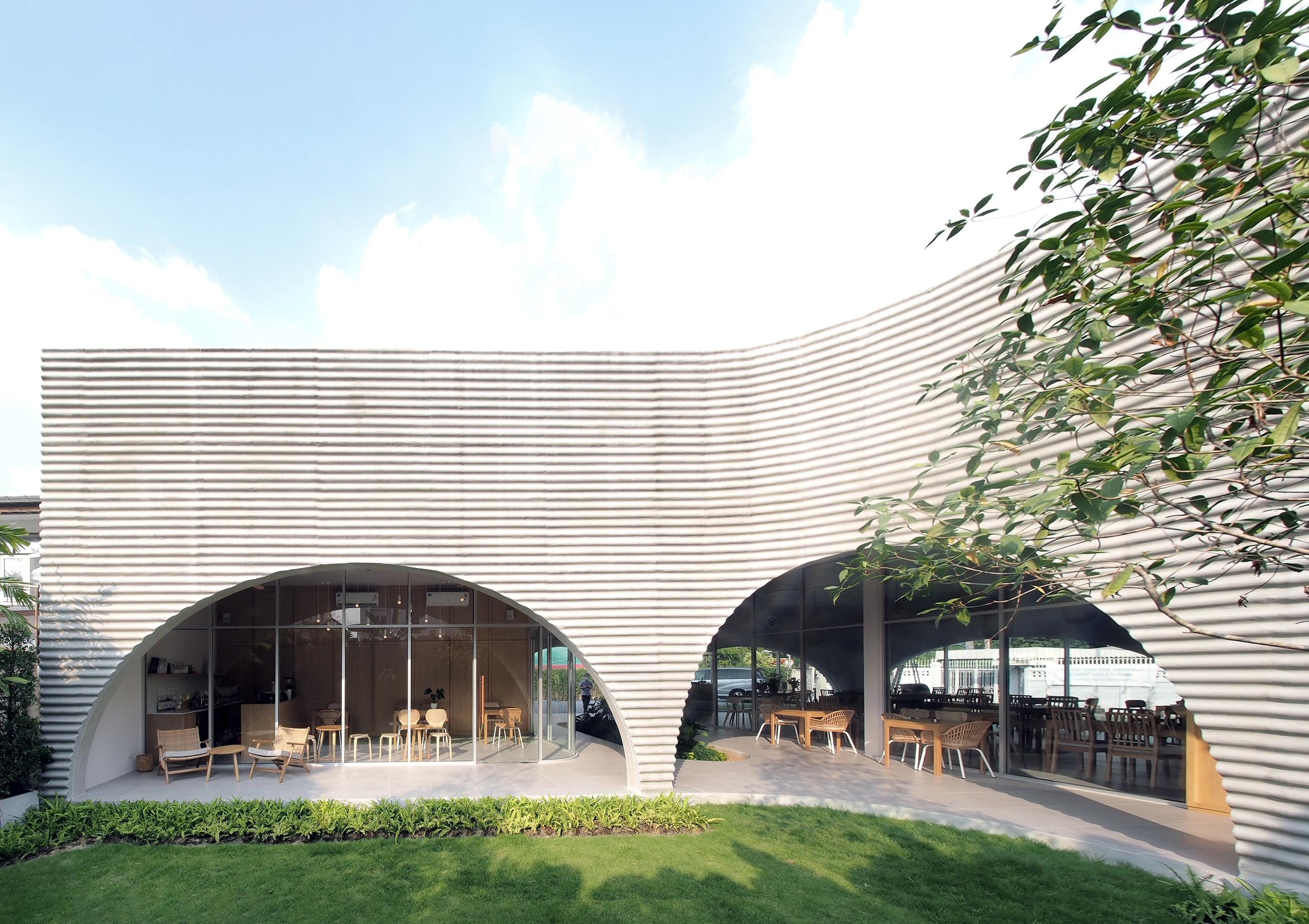
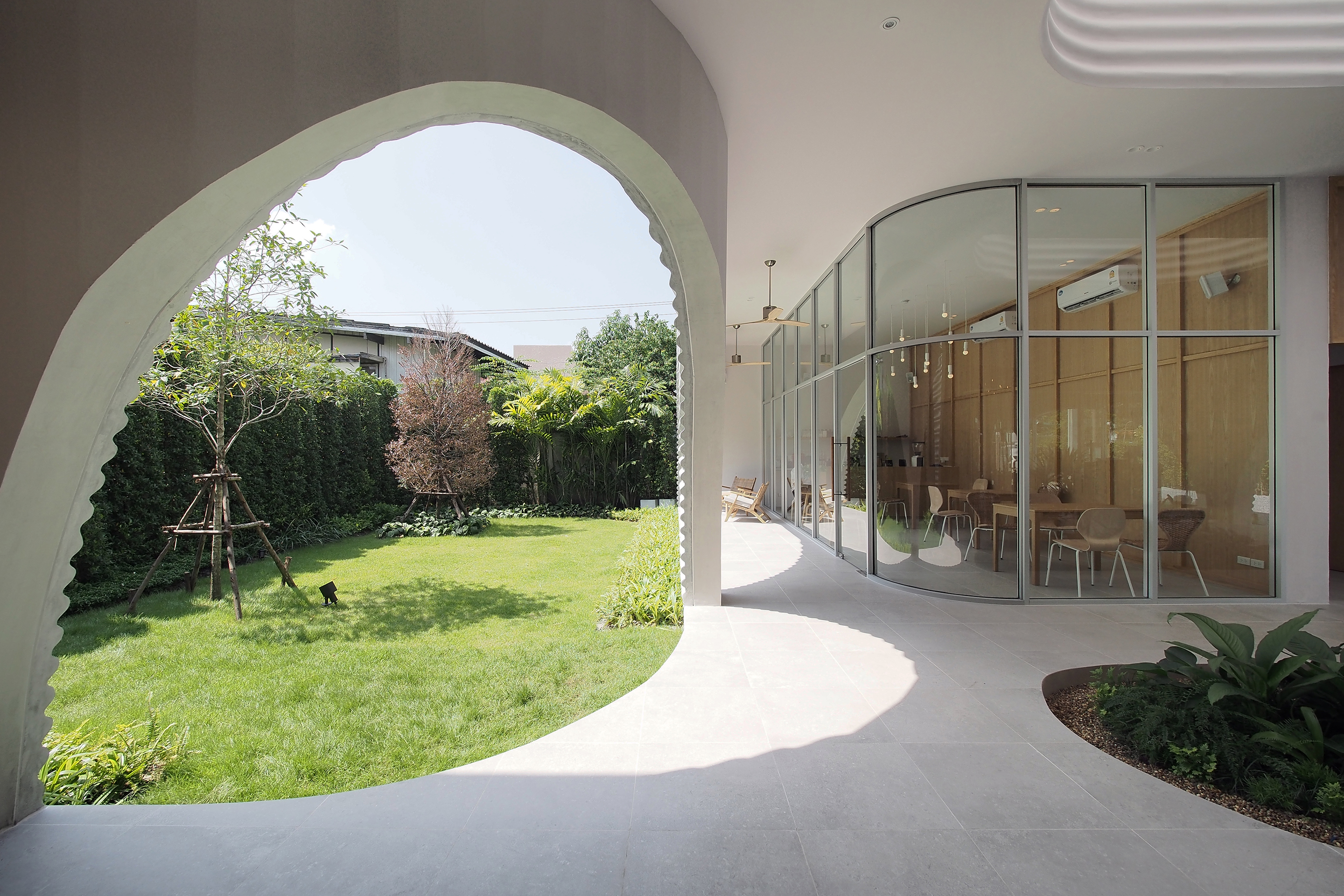 ASWA designed the new Khao Niao + Onda cafe in Bangkok’s Ari neighborhood, surrounded by residential buildings and other eateries. The one-story, L-shaped restaurant features a wavy precast concrete facade, crafted using a unique onsite mold created from corrugated roof tiles.
ASWA designed the new Khao Niao + Onda cafe in Bangkok’s Ari neighborhood, surrounded by residential buildings and other eateries. The one-story, L-shaped restaurant features a wavy precast concrete facade, crafted using a unique onsite mold created from corrugated roof tiles.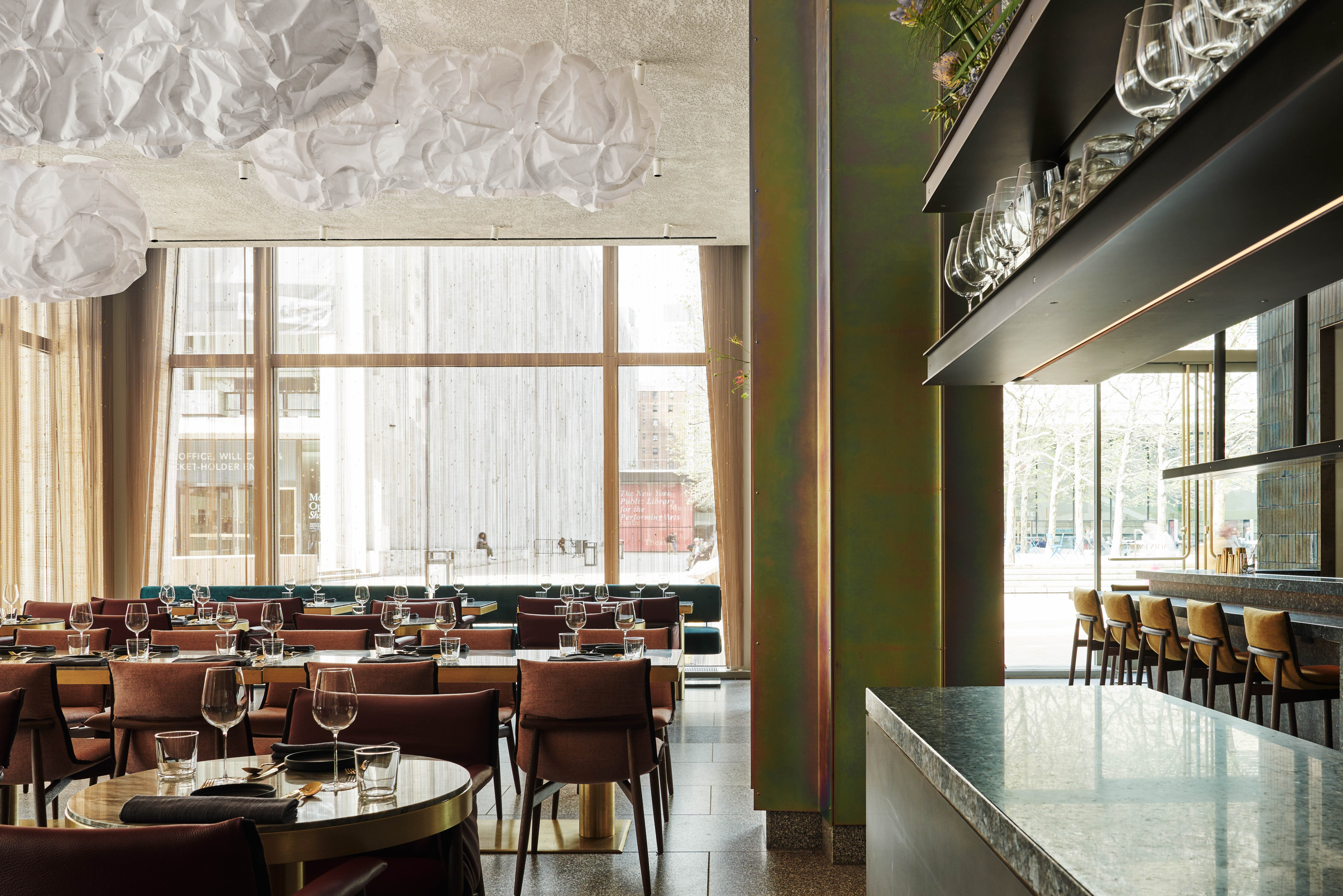
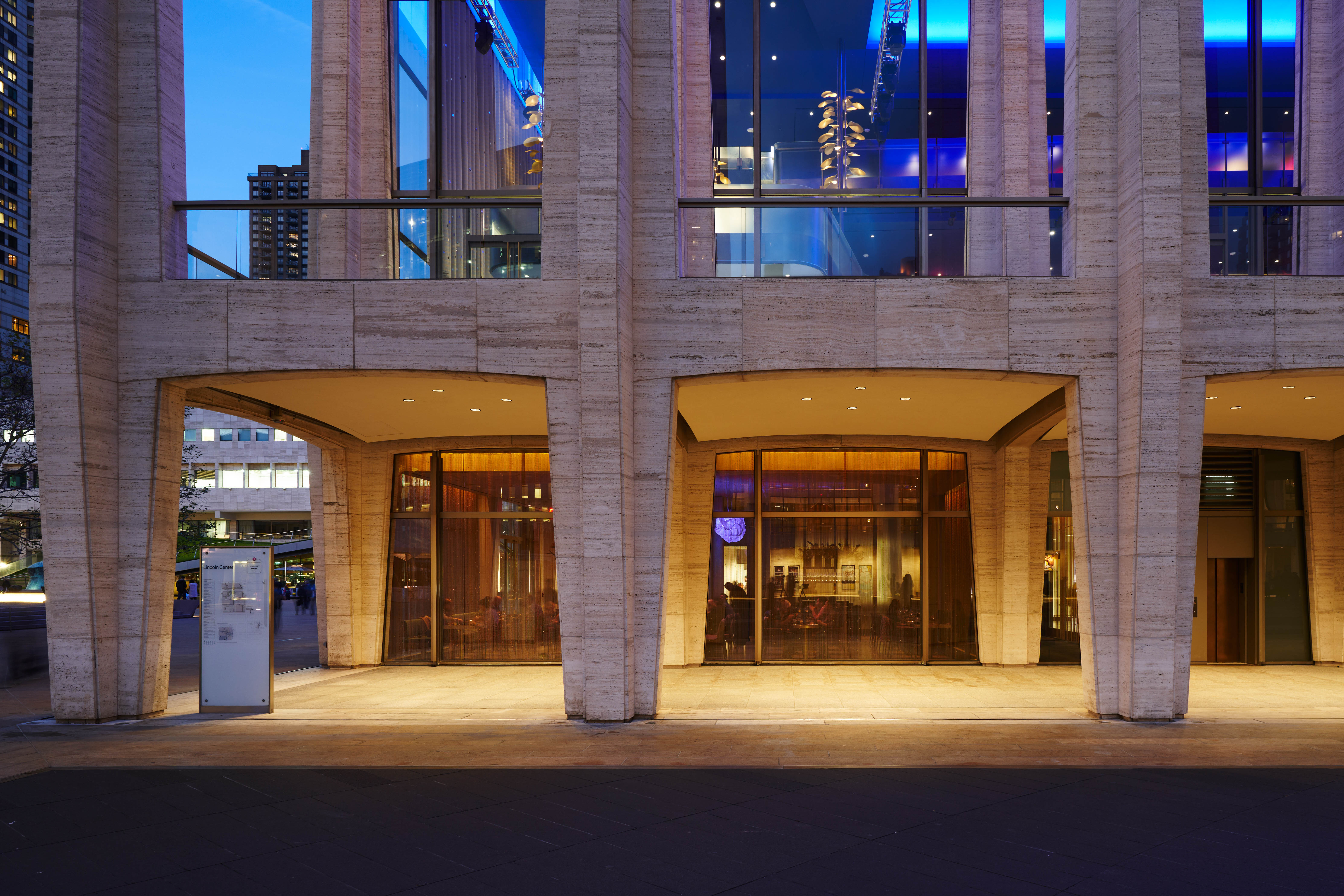 David Geffen Hall at Lincoln Center, completed in 2022, represents a rebirth of one of New York City’s most iconic institutions. Modellus Novus reimagined the concert hall’s hospitality spaces to honor the history and communities that once thrived in the area, particularly the Afro-Caribbean San Juan Hill neighborhood that was razed for Lincoln Center’s development.
David Geffen Hall at Lincoln Center, completed in 2022, represents a rebirth of one of New York City’s most iconic institutions. Modellus Novus reimagined the concert hall’s hospitality spaces to honor the history and communities that once thrived in the area, particularly the Afro-Caribbean San Juan Hill neighborhood that was razed for Lincoln Center’s development.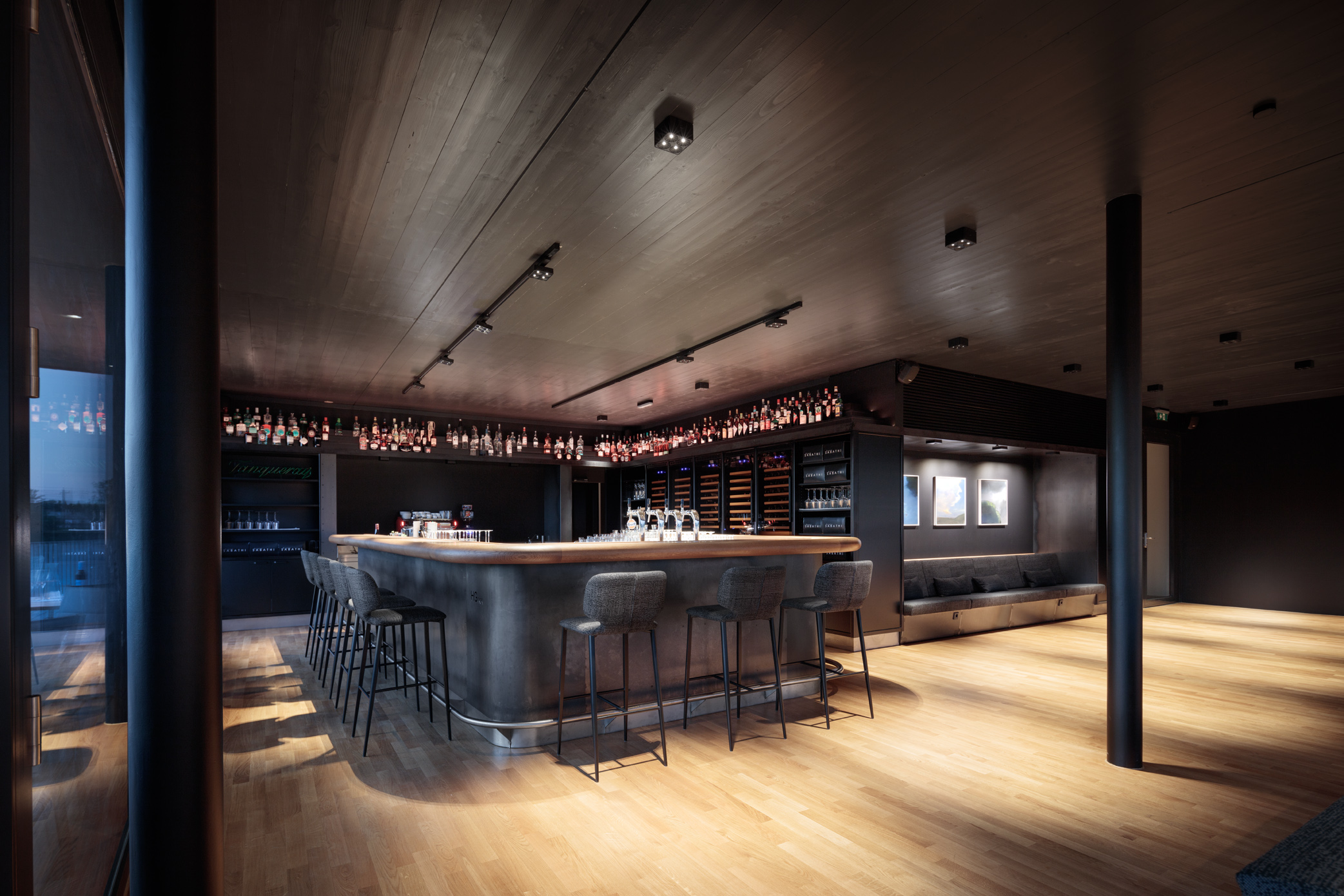
 The “V8” is a key component of the “Classic Depot” project in Vienna, designed to preserve valuable vintage vehicles. Located on the former Fritze-Lacke factory site, the facility features an underground parking level for 50 cars, a ground-floor workshop and storage areas with heated and ventilated spaces, UV-protective glass, and sun protection.
The “V8” is a key component of the “Classic Depot” project in Vienna, designed to preserve valuable vintage vehicles. Located on the former Fritze-Lacke factory site, the facility features an underground parking level for 50 cars, a ground-floor workshop and storage areas with heated and ventilated spaces, UV-protective glass, and sun protection.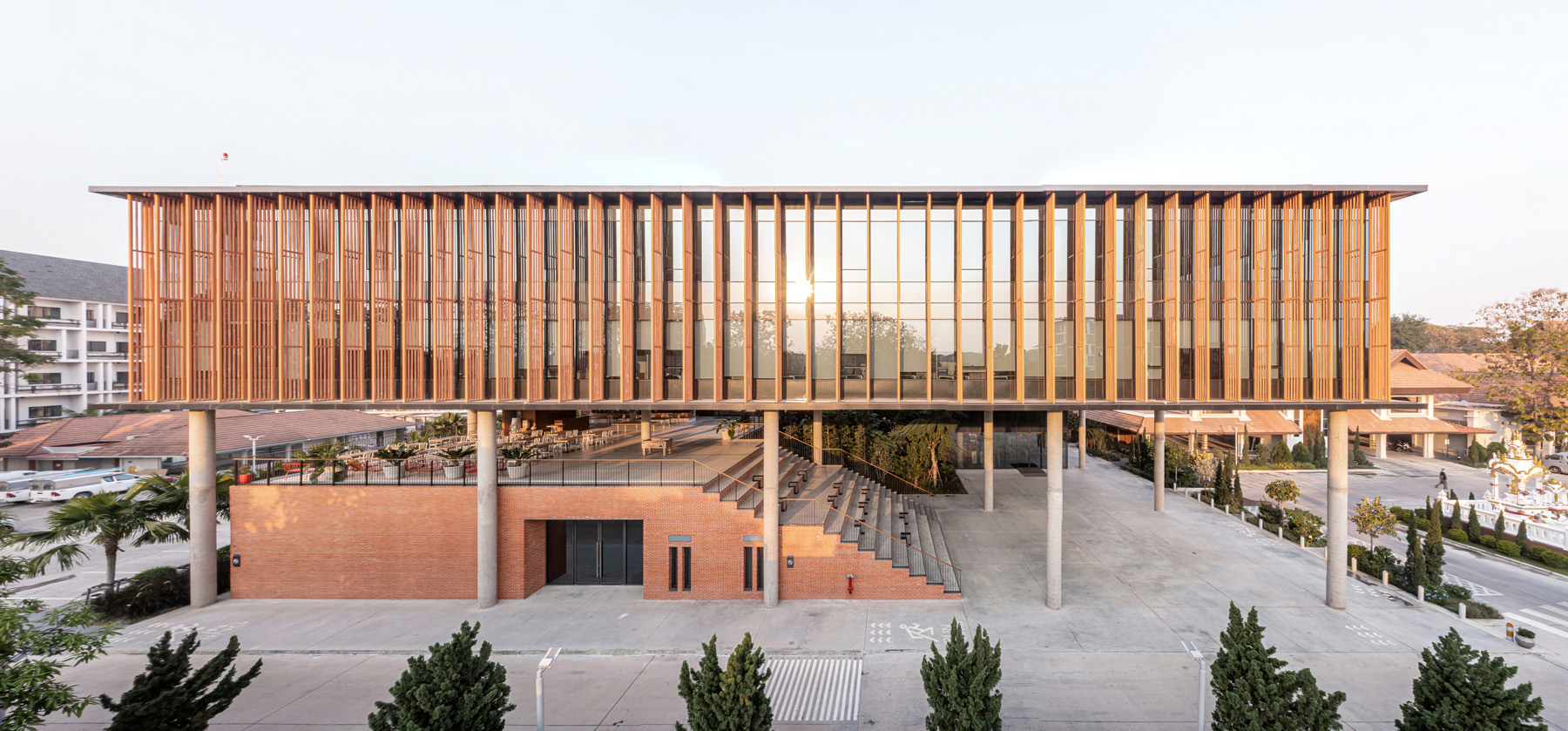
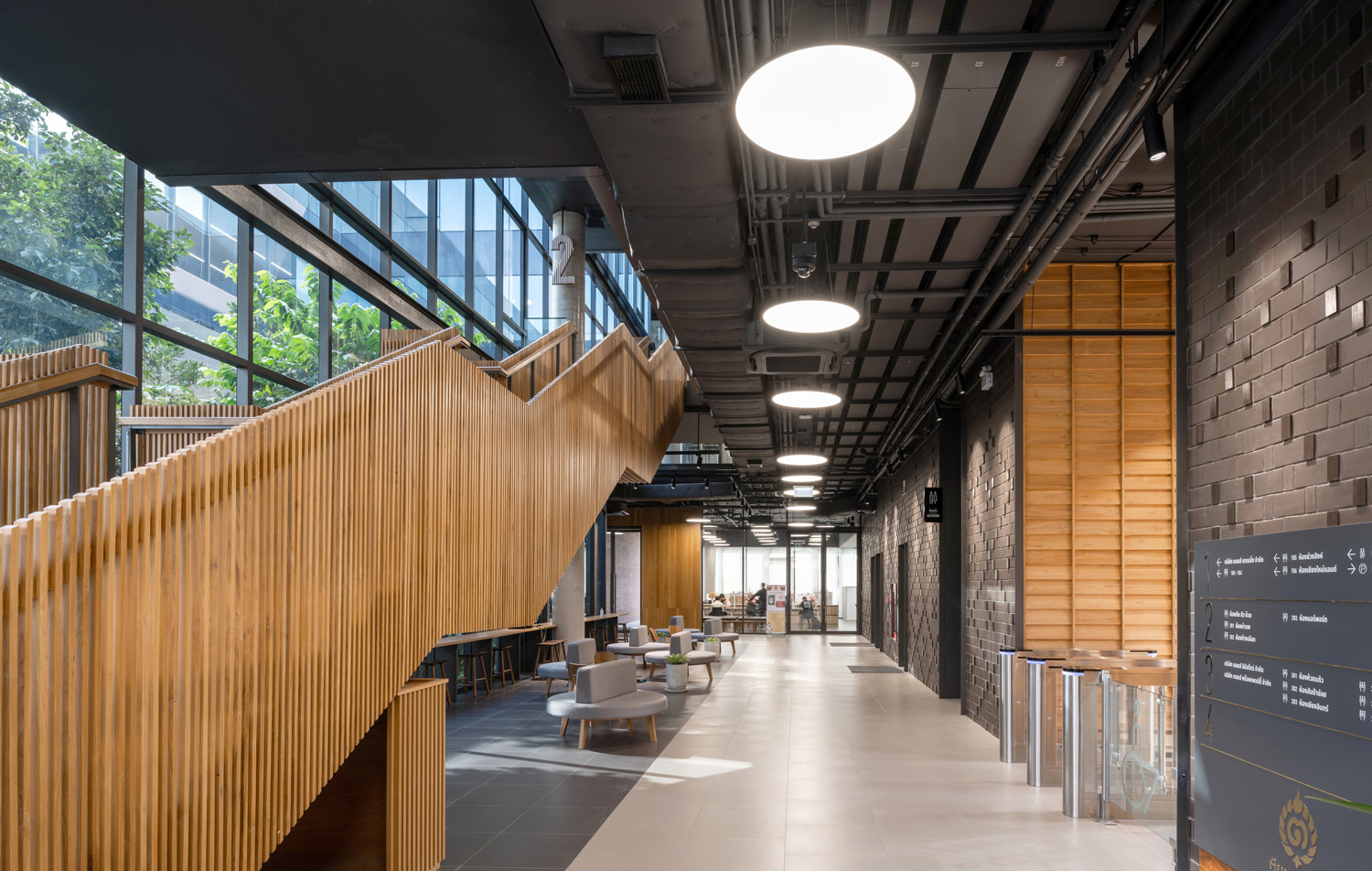 Choice Headquarters is located in Amphoe Mueang, Chiang Mai, surrounded by cultural treasures like Long-kao (rice harvest houses), the Wall of Chiang Mai, and traditional Thai terraces. These elements are thoughtfully integrated into the modern architecture, which features a simple plan with a four-story reinforced concrete structure centered around a courtyard that brings natural sunlight into the building.
Choice Headquarters is located in Amphoe Mueang, Chiang Mai, surrounded by cultural treasures like Long-kao (rice harvest houses), the Wall of Chiang Mai, and traditional Thai terraces. These elements are thoughtfully integrated into the modern architecture, which features a simple plan with a four-story reinforced concrete structure centered around a courtyard that brings natural sunlight into the building.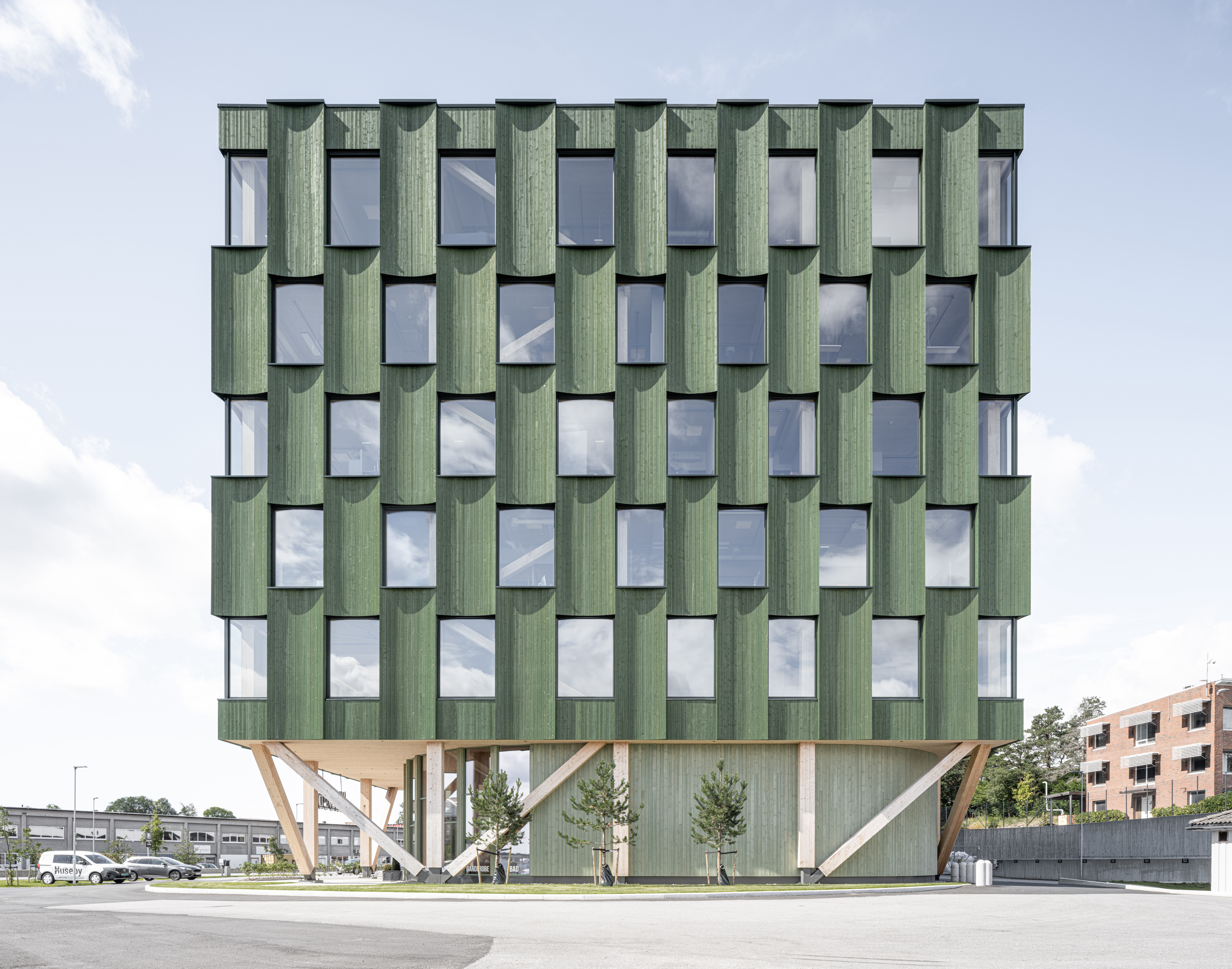
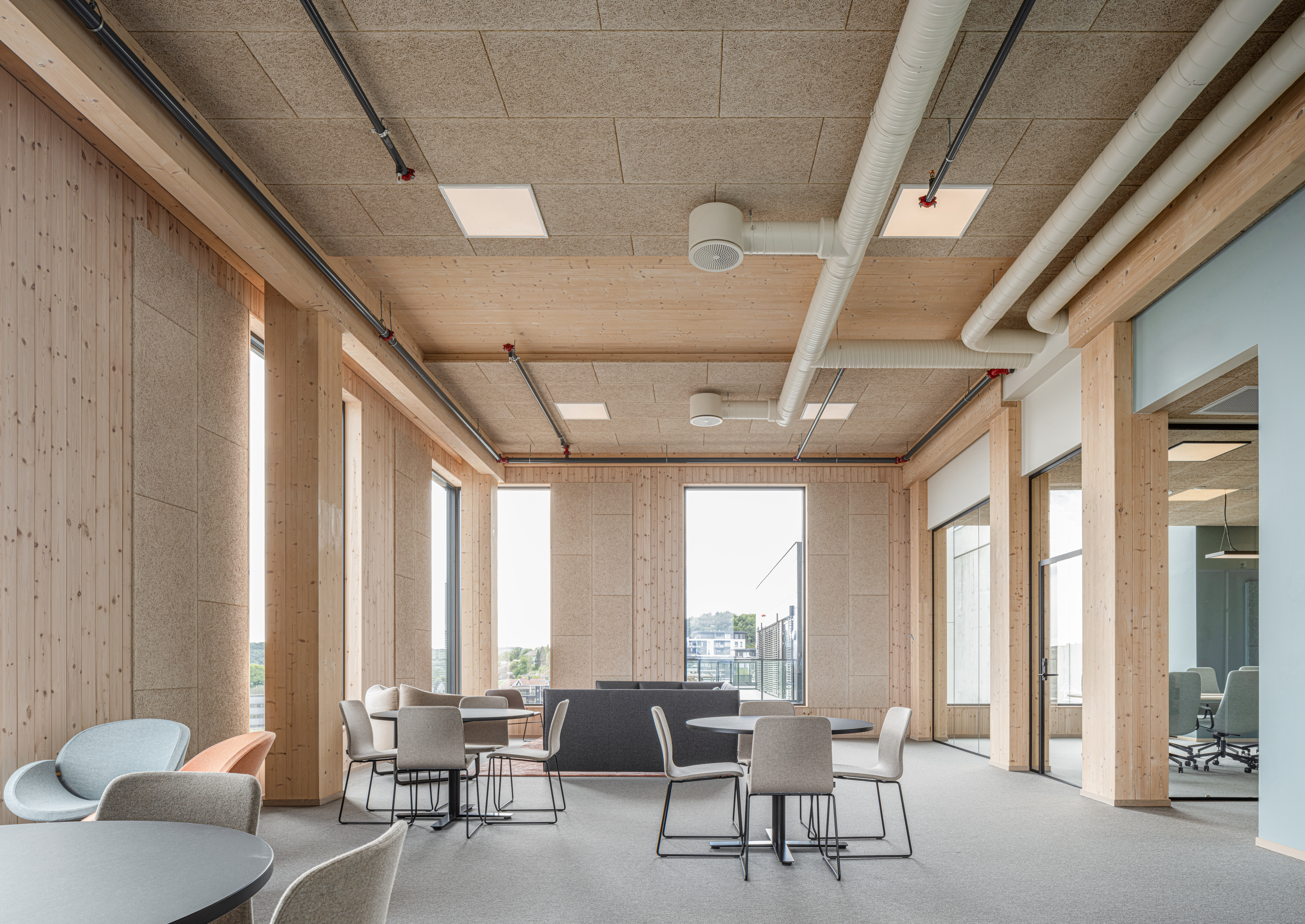 “Lumber 4” is a six-floor commercial and office building with a recessed ground floor for commercial use and five upper floors dedicated to office spaces. The structure features mass timber construction, with glued laminated timber columns and beams, and floors made from a composite of CLT and concrete. This slim, efficient floor system spans long distances while meeting fire and acoustic requirements. The building includes diagonals on the ground floor for better vehicular access and utilizes the existing communication core from adjacent phases for lateral stability and access to office floors.
“Lumber 4” is a six-floor commercial and office building with a recessed ground floor for commercial use and five upper floors dedicated to office spaces. The structure features mass timber construction, with glued laminated timber columns and beams, and floors made from a composite of CLT and concrete. This slim, efficient floor system spans long distances while meeting fire and acoustic requirements. The building includes diagonals on the ground floor for better vehicular access and utilizes the existing communication core from adjacent phases for lateral stability and access to office floors.
 The KNEM Offices are located on a plot that was once part of the former jute spinning mill of Hermanos Godó, known as “El Cànem.” The façade of the existing building facing Doctor Trueta Street, included in the Architectural Heritage Protection Plan, has been preserved. The program is distributed in three volumes: two blocks facing the streets and a central block that joins them through a large landscaped patio.
The KNEM Offices are located on a plot that was once part of the former jute spinning mill of Hermanos Godó, known as “El Cànem.” The façade of the existing building facing Doctor Trueta Street, included in the Architectural Heritage Protection Plan, has been preserved. The program is distributed in three volumes: two blocks facing the streets and a central block that joins them through a large landscaped patio.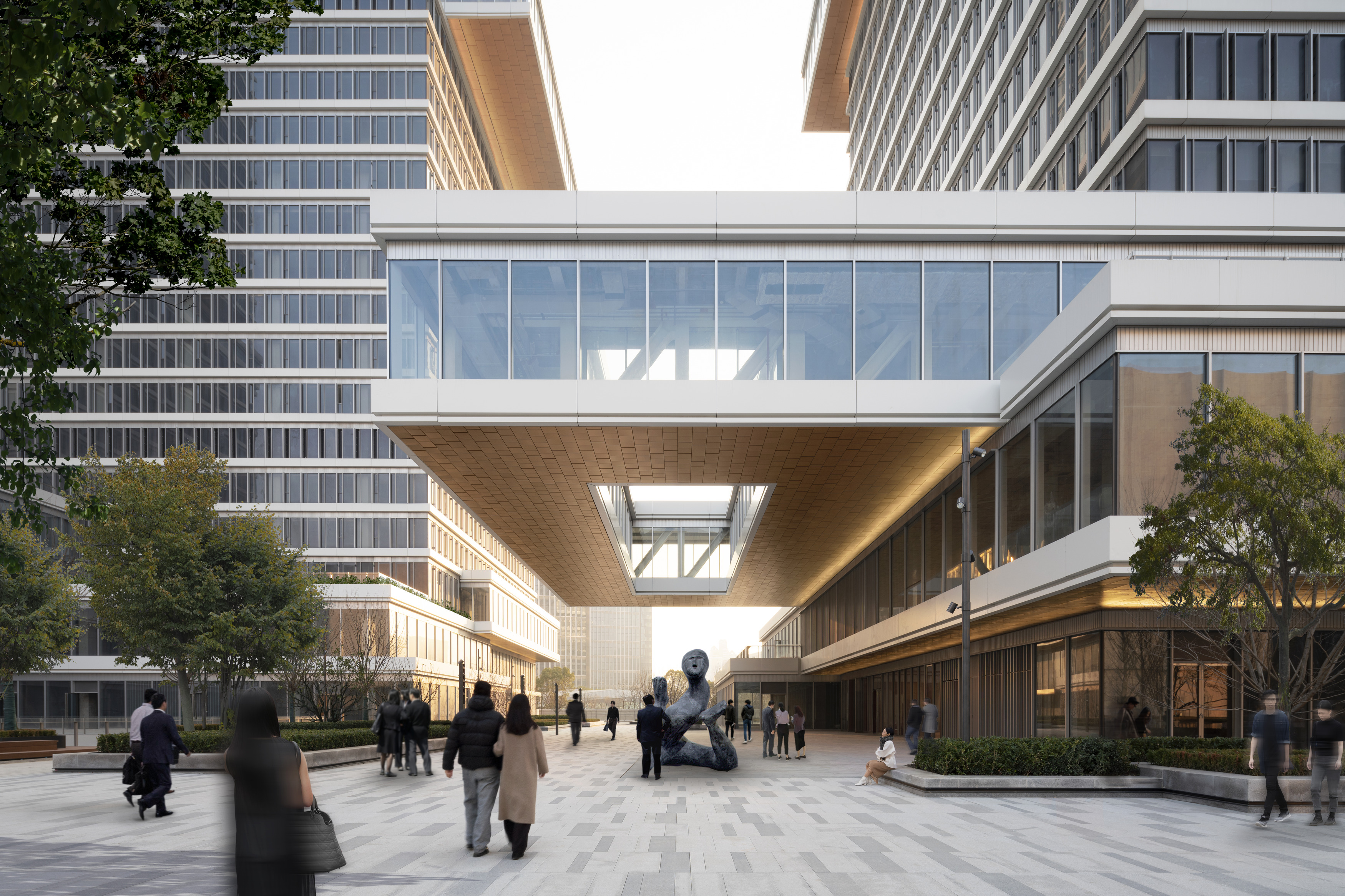
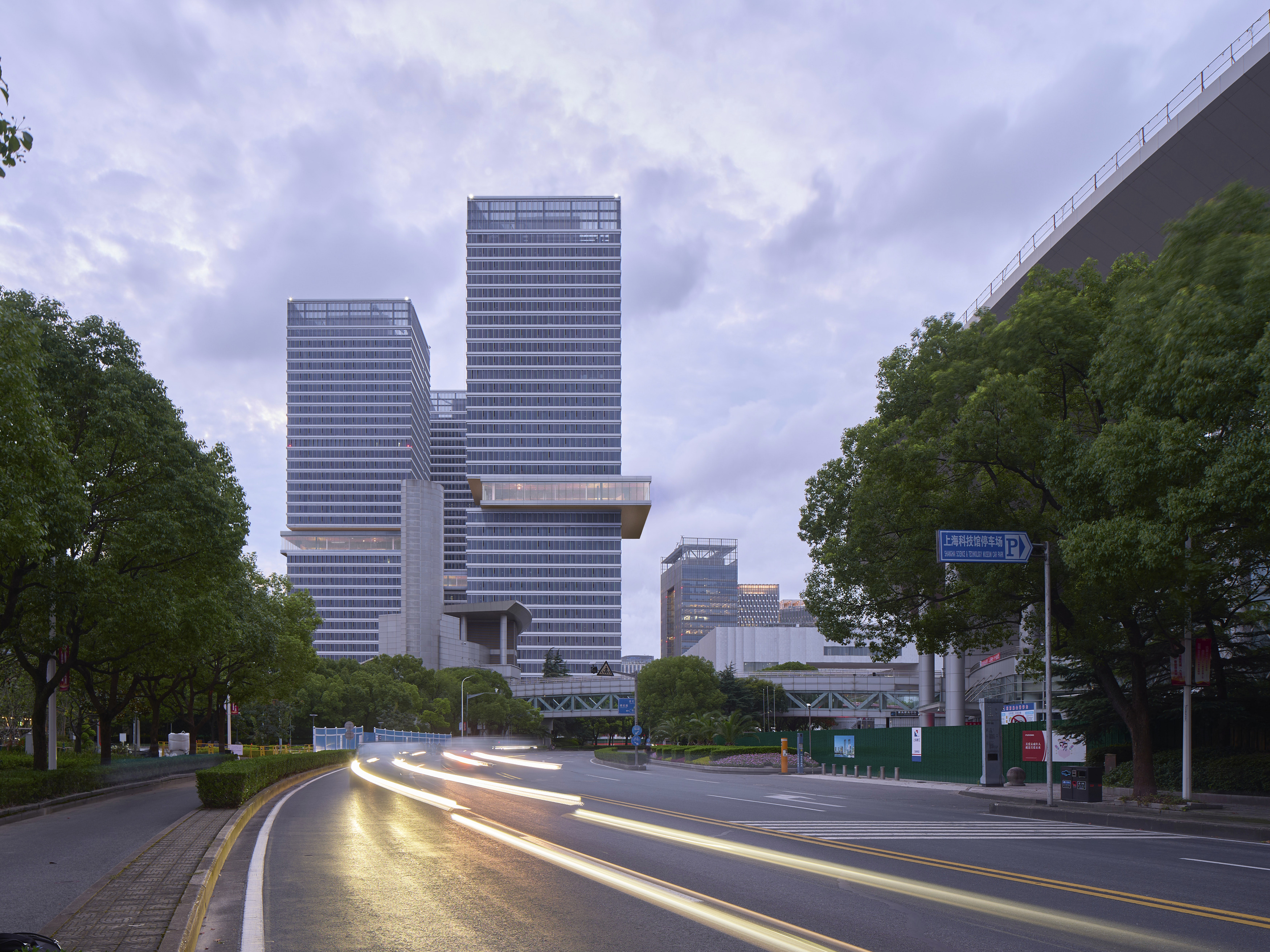 To create a sustainable mixed-use urban environment that invites tenants and visitors to experience nature and art in an active setting, Huamu Lot 10 showcases a new form of participatory urbanism. The project features three office towers and a future museum situated around a central grand plaza, landscaped with lush greenery, water features, and meandering walkways. This plaza, activated by surrounding cultural programming, is designed to accommodate large-scale artwork.
To create a sustainable mixed-use urban environment that invites tenants and visitors to experience nature and art in an active setting, Huamu Lot 10 showcases a new form of participatory urbanism. The project features three office towers and a future museum situated around a central grand plaza, landscaped with lush greenery, water features, and meandering walkways. This plaza, activated by surrounding cultural programming, is designed to accommodate large-scale artwork.
 Uniview Headquarters represents a modern, technology-driven corporate environment designed for efficiency, dynamism and functional integration. Nestled in Hangzhou’s high-tech industry zone, it extends to the southern tip of an urban landscape axis. A large sunken garden within the site connects to an urban park, serving as the district’s public green core. The headquarters’ west interface features a sweeping curve that embraces nature, while the south and east maintain a neat design, aligning with the surrounding cityscape.
Uniview Headquarters represents a modern, technology-driven corporate environment designed for efficiency, dynamism and functional integration. Nestled in Hangzhou’s high-tech industry zone, it extends to the southern tip of an urban landscape axis. A large sunken garden within the site connects to an urban park, serving as the district’s public green core. The headquarters’ west interface features a sweeping curve that embraces nature, while the south and east maintain a neat design, aligning with the surrounding cityscape.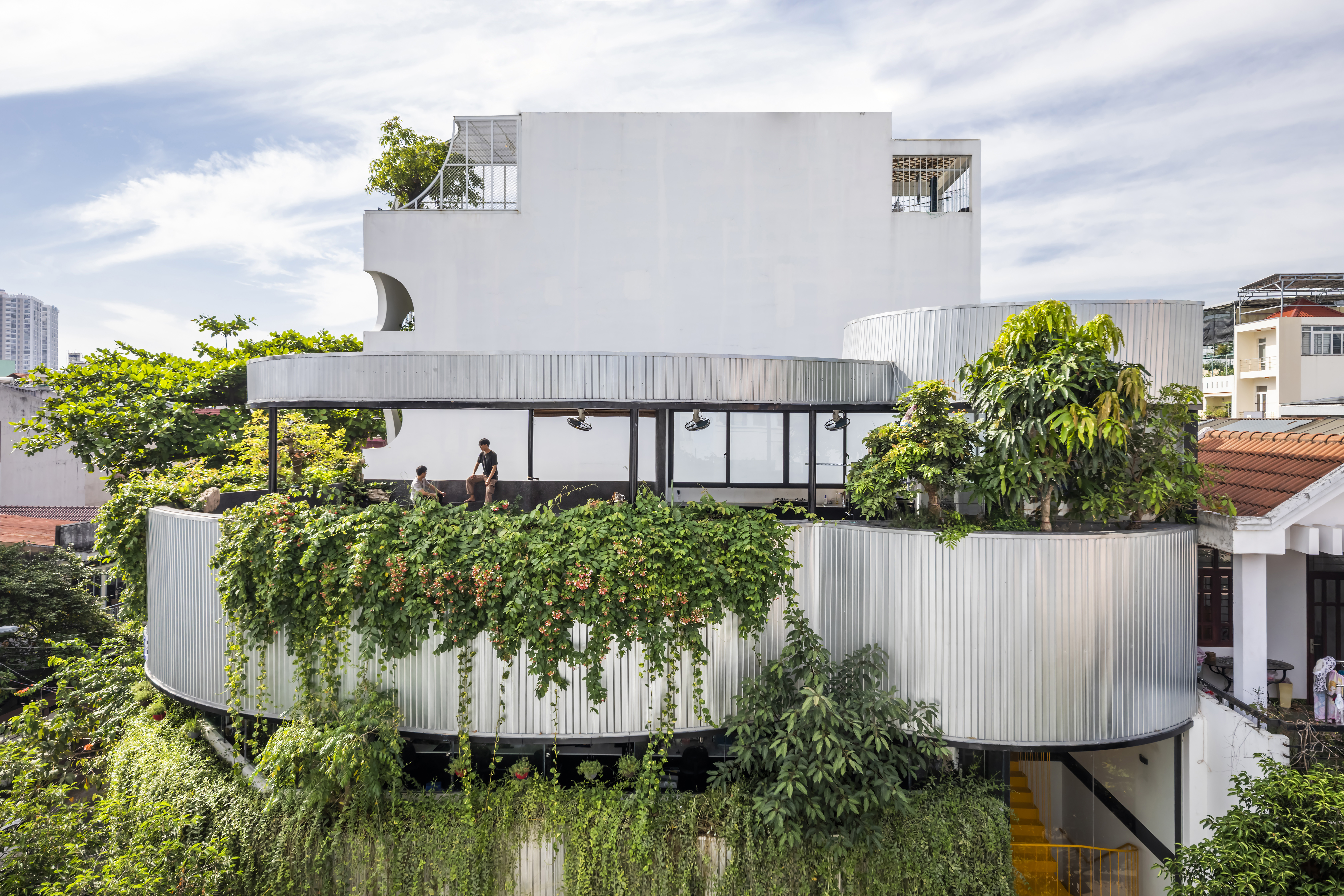
 Duntax Office, located in the Tan Phu District of Ho Chi Minh City, sits at an intersection with an open view but uninspiring surroundings. The construction faces challenges from global warming and environmental pollution, and the investor desired rapid completion with structural durability and city-landscape integration. The initial idea for the building was to use lightweight structures integrated with green patches and environmentally-friendly features, creating a modern workplace with an inspiring and serene atmosphere, detached from the hurried urban life.
Duntax Office, located in the Tan Phu District of Ho Chi Minh City, sits at an intersection with an open view but uninspiring surroundings. The construction faces challenges from global warming and environmental pollution, and the investor desired rapid completion with structural durability and city-landscape integration. The initial idea for the building was to use lightweight structures integrated with green patches and environmentally-friendly features, creating a modern workplace with an inspiring and serene atmosphere, detached from the hurried urban life.

